
Mortellaro's Nursery
Shrubs, trees, ground covers, native plants, and seasonal color
Wholesale Only
Click on any of the alpha indexes below to view the corresponding lists of plants.
The default list is displayed alphabetically by common name for all plant types. You can view the plants by clicking on the Scientific Name or limit the plant type by using the drop down.
Plants actively being grown for the current season are shown -- selecting Discontinued Items will show plants we have offered in the past.

|
Abelia, Edward GoucherBotanical Name: Abelia x grandiflora 'Edward Goucher'
Derived from a cross between Abelia x grandiflora and Abelia schumannii, the Edward Goucher Abelia boasts a captivating blend of features that make it an exceptional choice for any garden. This moderately fast-growing shrub showcases a naturally round growth habit, typically reaching a maximum height and width of four feet, making it an ideal selection for compact spaces. One of the standout attributes of the Edward Goucher Abelia is its profusion of pink blooms, which grace the plant from spring through frost. Noteworthy is the fact that these blooms emerge solely on new growth, ensuring a continuous display of color throughout the growing season. While optimal flowering is achieved in full sun, this resilient shrub is adaptable enough to thrive in partially shaded areas, ensuring versatility in landscaping designs. Adding to its allure is the striking foliage transformation throughout the seasons. New growth emerges in a captivating shade of purple, gradually transitioning to a lush green hue during the summer months before culminating in a bronze-green spectacle in the fall, lending visual interest year-round. Gardeners will appreciate the low-maintenance nature of the Edward Goucher Abelia, as it exhibits minimal susceptibility to pests and requires little upkeep. A simple application of fertilizer in late winter is all that is needed to support its healthy growth and prolific blooming. [ More Info ]
|
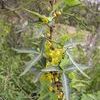
|
Agarita, TexasBotanical Name: Berberis trifoliolata
[ More Info ]
|
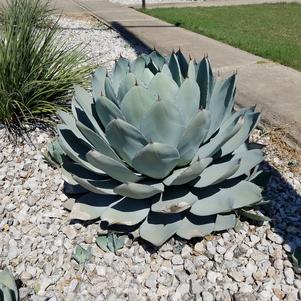
|
Agave, ArtichokeBotanical Name: Agave truncata
Dense Agave with wide but short leaves with a blue-gray color. Large terminal spines are on the end of each leaf, and smaller spines along leaf edge as it gets older. The natural shape of this Agave gives it its name, as it does resemble a rather large artichoke at 2 feet tall and 2 to 3 feet wide. [ More Info ]
|
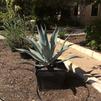
|
Agave, Century PlantBotanical Name: Agave americana
The largest of the Agave that forms a natueral rosette pattern. A single massive flower stalk appearing anytime between 10 to 25 years from germination, and can reach up to 15 feet. Cluster of greenish-white flowers appear, at which time the main plant begins to die. After the Century Plant is dead, multiple offshoots from the underground rhizomes will start to grow. Leaves have sharp spines that require care when handling, and should not be planted too close to walkways. Avoid planting in poorly drained areas. [ More Info ]
|
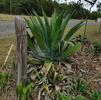
|
Agave, FeroxBotanical Name: Agave salmiana 'Ferox'
Cultivar of the Giant Agave that does not get as large, but still has the multitude of spines along leaf margins and large terminal spine. Maturity can take up to 15 years as well, with bright yellow blooms on a leaf stalk reaching over 10 feet in height. [ More Info ]
|
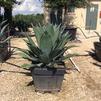
|
Agave, GiantBotanical Name: Agave salmiana
Large maturing agave with leaf spines along the margins and a terminal spice that can reach up to 3 inches. Estimated 15 years to reach maturity, at which point a flower stalk reaching 20 feet will display yellow flowers before dying, leaving many offshoots. [ More Info ]
|
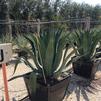
|
Agave, weberiBotanical Name: Agave weberi
Large Agave that forms a natueral rosett pattern, and can put out offsets through underground rhizomes. Massive flower stalks reach up to 20 feet in the middle of summer and can reach up to 10 feet tall with yellow blooms. Leaves have a sharp spine on the tip of the leaf that require care when handling, and should not be planted too close to walkways. Avoid planting in poorly drained areas. [ More Info ]
|

|
Agave, weberiBotanical Name: Agave weberi 'X'
Large Agave that forms a natueral rosett pattern, and can put out offsets through underground rhizomes. Massive flower stalks reach up to 20 feet in the middle of summer and can reach up to 10 feet tall with yellow blooms. Weberi X has jagged leaf spines while weberi does not. Leaves have a sharp spine on the tip of the leaf that require care when handling, and should not be planted too close to walkways. Avoid planting in poorly drained areas. [ More Info ]
|
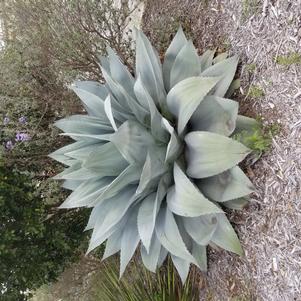
|
Agave, Whale's TongueBotanical Name: Agave ovatifolia 'Vanzie'
Large Agave that forms a natural rosette pattern, and can put out offsets through underground rhizomes. The plant can grow up to 36" tall overall, with flower stalks reaching much further. Blooms once full mature, which could take up to 15 years. Leaves have a sharp spine on the tip of the leaf and more along the leaf margin -- requires care when handling, and should not be planted too close to walkways. Avoid planting in poorly drained areas. [ More Info ]
|

|
Agave, Whale's Tongue Frosty BlueBotanical Name: Agave ovatifolia 'Frosty Blue'
Large Agave that forms a natural rosette pattern, and can put out offsets through underground rhizomes. The plant can grow up to 36" tall overall, with flower stalks reaching much further. Blooms once full mature, which could take up to 15 years. Leaves have a sharp spine on the tip of the leaf and more along the leaf margin -- requires care when handling, and should not be planted too close to walkways. Avoid planting in poorly drained areas. [ More Info ]
|
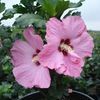
|
Althea, AphroditeBotanical Name: Hibiscus syriacus 'Aphrodite'
Althea 'Aphrodite', also known as Hibiscus syriacus 'Aphrodite', is a stunning deciduous shrub that adds elegance and beauty to any landscape. With its lush, green foliage and large, showy flowers, 'Aphrodite' commands attention throughout the growing season. The blooms are strikingly attractive, boasting a vibrant pink color with a deep red eye at their center, creating a mesmerizing focal point in garden beds or along property borders. This cultivar typically reaches a height and spread of around 10 feet, making it an excellent choice for adding height and structure to the landscape. From a landscaping perspective, Althea 'Aphrodite' offers versatility and resilience, thriving in various soil types and tolerating both drought and heat once established. Its upright, vase-shaped growth habit makes it suitable for use as a specimen plant, hedge, or screen, providing privacy and visual interest in the garden. 'Aphrodite' also attracts pollinators like bees and butterflies, enhancing the biodiversity of the landscape. Whether planted as a standalone specimen or incorporated into mixed borders, this hibiscus cultivar elevates the aesthetic appeal of any outdoor space with its lush foliage and stunning blossoms. In terms of maintenance, Althea 'Aphrodite' is relatively low-maintenance, requiring only occasional pruning to maintain its shape and encourage prolific flowering. Pruning can be done in late winter or early spring before new growth emerges. Regular watering during dry spells and a layer of mulch to conserve moisture are beneficial for optimal growth and blooming.
Leaves are coarsely tooth and slightly tri-lobed, emerging late in the spring. Branches have a natural erect growth habit, forming a natural vase shape. [ More Info ]
|

|
Alyssum, SweetBotanical Name: Lobularia maritima
Popular bedding plant that is great for edgings and borders. Blooms start in early spring and continue to frost. Fragrant flowers can be white, pink, rose or purple. Generally pest free. Spring and Summer Annual Fall 2008 Cultivar Easter Bonnet Violet Easter Bonnet White Spring 2022 Cultivars [ More Info ]
|
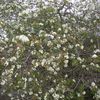
|
Anacacho Orchid TreeBotanical Name: Bauhinia lunarioides
[ More Info ]
|
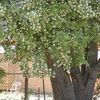
|
AnacuaBotanical Name: Ehretia anacua
The Anacua Tree stands as a symbol of resilience and beauty in the landscapes of South Texas and northeastern Mexico. With its distinctive glossy yet sandpaper texture leaves and clusters of small, fragrant white flowers, this native species captivates admirers and wildlife alike. Known for its ability to endure harsh conditions such as drought and poor soil, the Anacua Tree has earned a reputation as a hardy and versatile plant in its native habitat. One of the most notable features of the Anacua Tree is its role in providing sustenance for various wildlife species. The tree's fruits, resembling small oranges, are a favorite food source for birds and mammals. Additionally, its dense foliage offers shelter and nesting sites for birds, contributing to the local ecosystem's biodiversity. Furthermore, its resilience to drought and ability to thrive in sandy or clay soils make it a valuable component of xeriscaping efforts and urban landscaping projects in arid regions. Culturally, the Anacua Tree holds significance beyond its ecological contributions. Indigenous peoples of the region have long utilized its wood for various purposes, including crafting tools and building shelters. Furthermore, its presence in the landscape serves as a reminder of the natural heritage and resilience of the South Texas and northeastern Mexico regions. As efforts to preserve native flora continue, the Anacua Tree remains a cherished emblem of the rich botanical diversity and cultural heritage of its native range. [ More Info ]
|
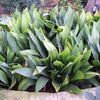
|
AspidistraBotanical Name: Aspidistra elatior
Amongst all the landscape plant offerings, Cast Iron stands out as the one plant without stems or a trunk. It is a perennial with leathery tough leaves that emerge directly from the underground rhizome, reaching a mature height of three feet. It earned its name for the ability to grow in low-light areas combined with minimal care or maintenance. It makes an ideal indoor plant due to its hardy nature. Aspidistra is unfortunately extremely slow growing, taking over a year to completely fill out a simple small gallon size container pot. Inconspicuous small purple flowers appear at the base of the plant in the spring. A variegated cultivar exists that has white markings streaked vertically on the leaves. Be sure to grow in well-draining soils to prevent root-rot. [ More Info ]
|
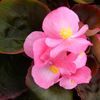
|
BegoniaBotanical Name: Begonia x semperflorens-cultorum
2024 Cultivars Begonia semp. 'Cocktail Gin' (Rose Pink) [ More Info ]
|
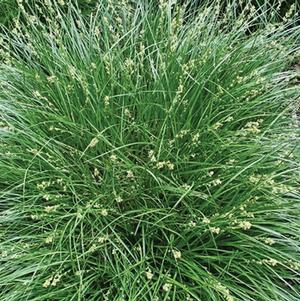
|
Berkeley SedgeBotanical Name: Carex divulsa
Evergreen clump forming grass that stays at an easily manageable size, while remaining maintenance and pest free once established in the landscape. Greenish flowers blend in with the bright green leaves, turning brown in the early winter. Ideal for grassy borders or mass plantings. Reseeds and returns in the spring easily. [ More Info ]
|

|
Blue Fescue GrassBotanical Name: Festuca glauca 'Elijah Blue'
[ More Info ]
|
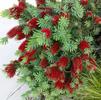
|
Bottlebrush, DwarfBotanical Name: Callistemon citrinus 'Little John'
From the land down under comes this spectacular blooming tree that prefers the warmer areas of southern Texas. The Bottlebrush is also called the Lemon Bottlebrush for the citrus aroma the leaves have when crushed. This low maintenance tree has a slow growth habit, with stiff stems that spread up and outright more than downward. The narrow lance-shaped leaves have a leathery touch to them, and are slightly tomentose on the underside. Bright red fuzzy flowers are on the stem tips, arranged radially and being entirely composed of stamens giving it the look of a large bottlebrush; they appear in abundance during the spring and sporadically throughout the summer. ‘Little John’ is a dwarf cultivar, with a more compact growth habit and higher susceptibility to freezing temperatures. It prefers well drained loose soils that are slightly acidic, and requires mulching in areas that experience cold winters. Easily attracts butterflies and hummingbirds when in bloom. [ More Info ]
|

|
BougainvilleaBotanical Name: Bougainvillea x 'Variegated Vickie'
Bougainvillea is one of the most captivating blooming vines used around Texas. Native to South America, these thorny woody vines grow up to 30 feet long in warm climates; semi-evergreens that drop their leaves in colder climates. Popular in hanging baskets or containers so that they can be protected in the colder regions as freezing temperatures can kill them. [ More Info ]
|
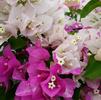
|
BougainvilleaBotanical Name: Bougainvillea x 'White Touch of Pink'
Bougainvillea is one of the most captivating blooming vines used around Texas. Native to South America, these thorny woody vines grow up to 30 feet long in warm climates; semi-evergreens that drop their leaves in colder climates. Popular in hanging baskets or containers so that they can be protected in the colder regions as freezing temperatures can kill them. [ More Info ]
|
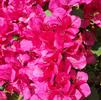
|
Bougainvillea, Barbara Karst (Red)Botanical Name: Bougainvillea x 'Red Barbara Karst'
Bougainvillea is one of the most captivating blooming vines used around Texas. Native to South America, these thorny woody vines grow up to 30 feet long in warm climates; semi-evergreens that drop their leaves in colder climates. Popular in hanging baskets or containers so that they can be protected in the colder regions as freezing temperatures can kill them. [ More Info ]
|
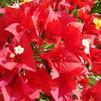
|
Bougainvillea, FlameBotanical Name: Bougainvillea x 'Flame'
Bougainvillea is one of the most captivating blooming vines used around Texas. Native to South America, these thorny woody vines grow up to 30 feet long in warm climates; semi-evergreens that drop their leaves in colder climates. Popular in hanging baskets or containers so that they can be protected in the colder regions as freezing temperatures can kill them. [ More Info ]
|

|
Bougainvillea, Juanita Hatten (Red)Botanical Name: Bougainvillea x 'Juanita Hatten'
Bougainvillea is one of the most captivating blooming vines used around Texas. Native to South America, these thorny woody vines grow up to 30 feet long in warm climates; semi-evergreens that drop their leaves in colder climates. Popular in hanging baskets or containers so that they can be protected in the colder regions as freezing temperatures can kill them. Juanita Hatten cultivar is one very similar to Barbara Karst, however the new foliage has a tinge of variegation that goes away as they mature. [ More Info ]
|
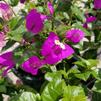
|
Bougainvillea, PurpleBotanical Name: Bougainvillea x 'Flame'
Bougainvillea is one of the most captivating blooming vines used around Texas. Native to South America, these thorny woody vines grow up to 30 feet long in warm climates; semi-evergreens that drop their leaves in colder climates. Popular in hanging baskets or containers so that they can be protected in the colder regions as freezing temperatures can kill them. [ More Info ]
|
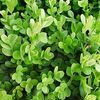
|
Boxwood, JapaneseBotanical Name: Buxus microphylla 'Japonica'
This Japanese native shrub is no stranger to the landscape, as it’s often the plant of choice for trimmed hedges, topiaries, and bonsai sculptures. Japanese Boxwood is an evergreen shrub with a multiple branching habit – combined with the dense growth habit of the leaves it naturally forms a thick round form. The glossy bright green leaves that only grow an inch give it a very uniformed feel when regularly trimmed or pruned. There are no noticeable flower or fruit characteristics. It’s important that the ground it is planted in has adequate drainage to avoid root rot; roots tend to stay shallow, so a thick layer of mulch can help maintain moisture. Appreciates morning sun and light, filtered afternoon shade. [ More Info ]
|
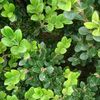
|
Boxwood, WintergemBotanical Name: Buxus microphylla 'Winter Gem'
This Japanese native shrub is no stranger to the landscape, as it’s often the plant of choice for trimmed hedges, topiaries, and bonsai sculptures. Japanese Boxwood is an evergreen shrub with a multiple branching habit – combined with the dense growth habit of the leaves it naturally forms a thick round form. “Winter Gem” has glossy dark green leaves that only grown an inch give it a much uniformed feel when regularly trimmed or pruned. There are no noticeable flower or fruit characteristics. It’s important that the ground it is planted in has adequate drainage to avoid root rot; roots tend to stay shallow, so a thick layer of mulch can help maintain moisture. Appreciates morning sun and light, filtered afternoon shade. [ More Info ]
|
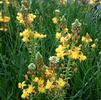
|
BulbineBotanical Name: Bulbine frutescens
South African native herbaceous perennial ideal for hot and dry Texas landscapes. Displays racemes of orange-yellow flowers throughout the warm months and spreads easily through the rhizome offsets and seeds. Grows best in well-drained soils, pest and maintenance free. [ More Info ]
|
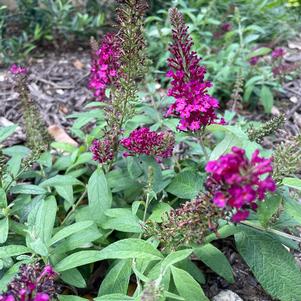
|
Butterfly Bush 'Chrysalis Cranberry'Botanical Name: Buddelia hybrid 'Chrysalis Cranberry'
Buddleia, commonly known as butterfly bush, is a genus of flowering plants that are known for attracting butterflies and other pollinators with their fragrant and colorful flowers. Buddleia plants are often grown for their ornamental value in gardens and landscaping. They are relatively easy to grow and can adapt to a wide range of soil conditions. Buddleias prefer full sun and well-drained soil. Chrysalis Cranberry is a trademarked plant that will stay in a compact form, avoiding that open weedy habit of a normal Buddleia. [ More Info ]
|
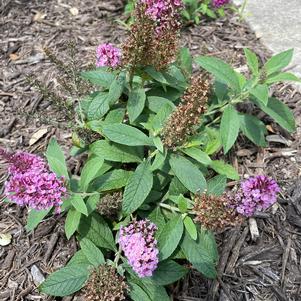
|
Butterfly Bush 'Chrysalis Pink'Botanical Name: Buddelia hybrid 'Chrysalis Pink'
Buddleia, commonly known as butterfly bush, is a genus of flowering plants that are known for attracting butterflies and other pollinators with their fragrant and colorful flowers. Buddleia plants are often grown for their ornamental value in gardens and landscaping. They are relatively easy to grow and can adapt to a wide range of soil conditions. Buddleias prefer full sun and well-drained soil. Chrysalis Pink is a trademarked plant that will stay in a compact form, avoiding that open weedy habit of a normal Buddleia. [ More Info ]
|
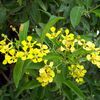
|
Butterfly VineBotanical Name: Mascagnia macroptera
A vigorous evergreen vine native to the tropical regions of South America that has adapted well in the southern Texas landscape. The vine easily spreads up to 15 feet, however if the stems touch ground, they sprout roots, allowing them to spread even further. Climbs most surfaces with ease, but does best with trellises or fences. Intense yellow blooms that look like small orchids appear early in the summer and continue to appear till fall. Papery samara fruits form after flowering that resemble large butterfly wings, giving this vine its name. Mulch heavily in the winter as it is vulnerable to freezing temperatures and protects it through the heat of the summer. [ More Info ]
|
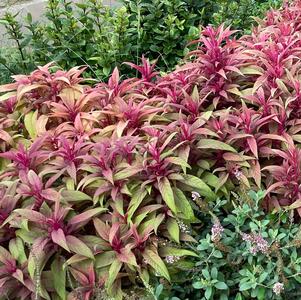
|
Celosia Dragon's BreathBotanical Name: Celosia argentea 'Dragons Breath®'
Celosia 'Dragon's Breath' is a striking annual plant renowned for its fiery foliage and unique appearance, making a bold statement in garden landscapes. Its vibrant, flame-colored plumes rise above lush green foliage, creating a captivating display of color and texture. 'Dragon's Breath' stands out for its compact growth habit, making it suitable for borders, containers, or mass plantings. This heat-tolerant and drought-resistant cultivar thrives in sunny locations with well-drained soil, providing a burst of color throughout the summer months. Its resilience and eye-catching aesthetics make it a popular choice for landscape designers and gardeners seeking to infuse their outdoor spaces with drama and intensity. [ More Info ]
|
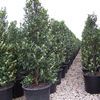
|
Cherry Laurel, CompactBotanical Name: Prunus caroliniana 'Compacta'
The Cherry Laurel species is native to East Texas where it thrives with the regular rainfall and acidic soils. It tolerates heat, drought, and wind so well, that it is utilized nearly anywhere Texas. ‘Compacta’ is a cultivar with more compact growth habit, smaller leaf size, and a maturing at half the size of the regular Cherry Laurel. The small bright-green leaves have the odor of maraschino cherries when crushed, and are toxic. Fragrant white flowers cover the branches in the early spring, easily attracting butterflies and bees. They are followed by small black cherry fruits that only wildlife can enjoy, as they are poisonous to us as well. Compact Cherry Laurel responds well to pruning, and often is sheared into cone shapes to keep its compact form. [ More Info ]
|

|
Chili PequinBotanical Name: Capsicum annumm 'pequin'
Chili pepper plant is a very productive semi-compact pepper plant with open free growth habit. Tiny peppers are enjoyed by birds leading it to be sprouting up all over the yard after a few years. [ More Info ]
|
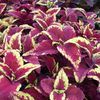
|
Coleus, MixedBotanical Name: Coleus x
Popular fast growing bedding plant for the summer that does best in filtered to full shade. Attractive foliage is opposite and simple, ovate leaves. Come in shades of yellow, dull red, purple, and pale green. Flowers are dark blue to cream, displayed in terminal spike-like racemes that reach three inches long. Coleus needs loose, well drained fertile soil, and does well as an underplanting. Mealy bugs are a problem when grown in full shade, and frequent trimming will ensure a thick bushy plant. 2010 Spring - Summer Cultivars : Burgundy Sun [ More Info ]
|
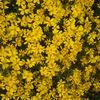
|
Copper Canyon DaisyBotanical Name: Tagetes lemmonii
Bushy perennial that heavily covers itself with yellow daisy-like blooms in the spring and fall, and intermittently during the summer. Great tolerance to hot and dry areas. Grows up to six feet tall and four feet wide, but can get weedy-looking and will recover quickly from pruning in the warm seasons. Foliage has a bitter aroma. [ More Info ]
|
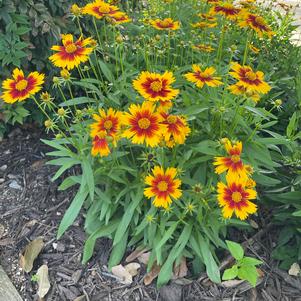
|
CoreopsisBotanical Name: Coreopsis UPTICK Gold & Bronze 'Baluptred'
Coreopsis Uptick Gold & Bronze is a delightful plant that is prized for its vibrant and showy blooms. The Uptick Gold & Bronze variety of Coreopsis has a compact and upright habit that grows up to 12-18 inches tall and spreads up to 12-16 inches wide. The leaves are lance-shaped and have a bright green color that forms a dense, bushy mound. The foliage is attractive even when the plant is not in bloom. The flowers of Coreopsis Uptick Gold & Bronze are the main attraction. They bloom profusely from early summer until fall, producing clusters of bright golden-yellow flowers with a bronze-red center. The flowers are 1-2 inches wide and have a distinctive daisy-like appearance. They are held atop sturdy stems that are well-suited to cutting for use in floral arrangements. Coreopsis Uptick Gold & Bronze is an easy-to-grow plant that thrives in full sun to partial shade and well-draining soil. It is drought-tolerant and can withstand some humidity. The plant is relatively low-maintenance and does not require much pruning or fertilization. Deadheading spent blooms will encourage continuous blooming throughout the growing season. [ More Info ]
|
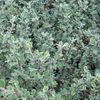
|
Cotoneaster, GrayleafBotanical Name: Cotoneaster glaucophyllus
Often mispronounced as the two separate words Coton and Easter, Cotoneaster is one of the more durable and hardy landscape shrubs for the Texas landscape. It tolerates urban conditions, poor soils, and even drought – but thrives when given favorable care. It has an appealing shade of gray-green foliage that is slightly pubescent, arranged on low arching branches that somewhat form a thicket. The small leaves and compact form allow to be pruned into thick hedges easily. Clusters of small white flowers appear on the branches throughout the spring, and are followed by red berries that persist throughout the fall. [ More Info ]
|
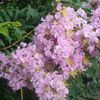
|
Crape Myrtle, BashamBotanical Name: Lagerstroemia indica 'Basham'
Lagerstroemia is a genus with over 50 species and numerous cultivars to offer trees, shrubs, and weeping shrubs that can be utilized for just about any purpose in the landscape. Crape Myrtles are primarily grown for their long-lasting blooms – up to 120 days! Most species also have a smooth bark that sheds thin layers throughout the year, uncovering inner bark that is shades of gray or even cinnamon-red. 'Basham' is a large growing cultivar with light pink blooms; it is a powdery mildew resistant cultivar. Flowers begin to emerge in the early summer after foliage, in panicles of crinkled small flowers with a crepe-like feel and look. They last longer if the plant is not terribly overwatered. When the blooms finally being to drop, they are followed by a large number of capsule fruits that can weigh down the branches. If it’s still early in the ear, prune the fruits to promote another round of flowering. If untrimmed, the large green fruits will dry out, turning into black husk that split open to release numerous small seeds. Blooms only appear on new branches, so it’s not uncommon to prune them in the winter. Unfortunately, larger specimens are often butchered back severely to encourage additional branches and many more blooms. Since most crape myrtles recover nicely, they are routinely victimized by those without taste. Simple opposite green leaves emerge early in the spring, and vary in size according to the cultivar. They turn a lovely shade of red, orange, or yellow in the fall. Crape Myrtles appreciate moist soils, but tolerate dry conditions once they are established.
[ More Info ]
|
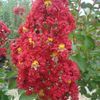
|
Crape Myrtle, DynamiteBotanical Name: Lagerstroemia indica 'Dynamite'
Lagerstroemia is a genus with over 50 species and numerous cultivars to offer trees, shrubs, and weeping shrubs that can be utilized for just about any purpose in the landscape. Crape Myrtles are primarily grown for their long-lasting blooms – up to 120 days! Most species also have a smooth bark that sheds thin layers throughout the year, uncovering inner bark that is shades of gray or even cinnamon-red. Flowers begin to emerge in the early summer after foliage, in panicles of crinkled small flowers with a crepe-like feel and look. They last longer if the plant is not terribly overwatered. When the blooms finally being to drop, they are followed by a large number of capsule fruits that can weigh down the branches. If it’s still early in the ear, prune the fruits to promote another round of flowering. If untrimmed, the large green fruits will dry out, turning into black husk that split open to release numerous small seeds. Blooms only appear on new branches, so it’s not uncommon to prune them in the winter. Unfortunately, larger specimens are often butchered back severely to encourage additional branches and many more blooms. Since most crape myrtles recover nicely, they are routinely victimized by those without taste. Simple opposite green leaves emerge early in the spring, and vary in size according to the cultivar. They turn a lovely shade of red, orange, or yellow in the fall. Crape Myrtles appreciate moist soils, but tolerate dry conditions once they are established. [ More Info ]
|
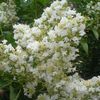
|
Crape Myrtle, NatchezBotanical Name: Lagerstroemia indica 'Natchez'
Lagerstroemia is a genus with over 50 species and numerous cultivars to offer trees, shrubs, and weeping shrubs that can be utilized for just about any purpose in the landscape. Crape Myrtles are primarily grown for their long-lasting blooms – up to 120 days! Most species also have a smooth bark that sheds thin layers throughout the year, uncovering inner bark that is shades of gray or even cinnamon-red. 'Natchez' is a large cultivar, one of the largest available, with bright white blooms. Flowers begin to emerge in the early summer after foliage, in panicles of crinkled small flowers with a crepe-like feel and look. They last longer if the plant is not terribly overwatered. When the blooms finally being to drop, they are followed by a large number of capsule fruits that can weigh down the branches. If it’s still early in the ear, prune the fruits to promote another round of flowering. If untrimmed, the large green fruits will dry out, turning into black husk that split open to release numerous small seeds. Blooms only appear on new branches, so it’s not uncommon to prune them in the winter. Unfortunately, larger specimens are often butchered back severely to encourage additional branches and many more blooms. Since most crape myrtles recover nicely, they are routinely victimized by those without taste. Simple opposite green leaves emerge early in the spring, and vary in size according to the cultivar. They turn a lovely shade of red, orange, or yellow in the fall. Crape Myrtles appreciate moist soils, but tolerate dry conditions once they are established. [ More Info ]
|
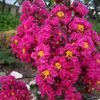
|
Crape Myrtle, Pink VelourBotanical Name: Lagerstroemia indica 'Pink Velour'
Lagerstroemia is a genus with over 50 species and numerous cultivars to offer trees, shrubs, and weeping shrubs that can be utilized for just about any purpose in the landscape. Crape Myrtles are primarily grown for their long-lasting blooms – up to 120 days! Most species also have a smooth bark that sheds thin layers throughout the year, uncovering inner bark that is shades of gray or even cinnamon-red. Pink Velour has burgundy-green leaves that get dark red-bronze in the fall, with pink blooms. Powdery Mildew resistant cultivar. Flowers begin to emerge in the early summer after foliage, in panicles of crinkled small flowers with a crepe-like feel and look. They last longer if the plant is not terribly overwatered. When the blooms finally being to drop, they are followed by a large number of capsule fruits that can weigh down the branches. If it’s still early in the ear, prune the fruits to promote another round of flowering. If untrimmed, the large green fruits will dry out, turning into black husk that split open to release numerous small seeds. Blooms only appear on new branches, so it’s not uncommon to prune them in the winter. Unfortunately, larger specimens are often butchered back severely to encourage additional branches and many more blooms. Since most crape myrtles recover nicely, they are routinely victimized by those without taste. Simple opposite green leaves emerge early in the spring, and vary in size according to the cultivar. They turn a lovely shade of red, orange, or yellow in the fall. Crape Myrtles appreciate moist soils, but tolerate dry conditions once they are established. [ More Info ]
|
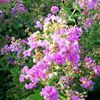
|
Crape Myrtle, PurpleBotanical Name: Lagerstroemia indica
Lagerstroemia is a genus with over 50 species and numerous cultivars to offer trees, shrubs, and weeping shrubs that can be utilized for just about any purpose in the landscape. Crape Myrtles are primarily grown for their long-lasting blooms – up to 120 days! Most species also have a smooth bark that sheds thin layers throughout the year, uncovering inner bark that is shades of gray or even cinnamon-red. 'Catawba' is a medium sized tree, with a fine rich purple bloom color. Flowers begin to emerge in the early summer after foliage, in panicles of crinkled small flowers with a crepe-like feel and look. They last longer if the plant is not terribly overwatered. When the blooms finally being to drop, they are followed by a large number of capsule fruits that can weigh down the branches. If it’s still early in the ear, prune the fruits to promote another round of flowering. If untrimmed, the large green fruits will dry out, turning into black husk that split open to release numerous small seeds. Blooms only appear on new branches, so it’s not uncommon to prune them in the winter. Unfortunately, larger specimens are often butchered back severely to encourage additional branches and many more blooms. Since most crape myrtles recover nicely, they are routinely victimized by those without taste. Simple opposite green leaves emerge early in the spring, and vary in size according to the cultivar. They turn a lovely shade of red, orange, or yellow in the fall. Crape Myrtles appreciate moist soils, but tolerate dry conditions once they are established.
[ More Info ]
|
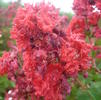
|
Crape Myrtle, RedBotanical Name: Lagerstroemia indica
Lagerstroemia is a genus with over 50 species and numerous cultivars to offer trees, shrubs, and weeping shrubs that can be utilized for just about any purpose in the landscape. Crape Myrtles are primarily grown for their long-lasting blooms – up to 120 days! Most species also have a smooth bark that sheds thin layers throughout the year, uncovering inner bark that is shades of gray or even cinnamon-red. Flowers begin to emerge in the early summer after foliage, in panicles of crinkled small flowers with a crepe-like feel and look. They last longer if the plant is not terribly overwatered. When the blooms finally being to drop, they are followed by a large number of capsule fruits that can weigh down the branches. If it’s still early in the ear, prune the fruits to promote another round of flowering. If untrimmed, the large green fruits will dry out, turning into black husk that split open to release numerous small seeds. Blooms only appear on new branches, so it’s not uncommon to prune them in the winter. Unfortunately, larger specimens are often butchered back severely to encourage additional branches and many more blooms. Since most crape myrtles recover nicely, they are routinely victimized by those without taste. Simple opposite green leaves emerge early in the spring, and vary in size according to the cultivar. They turn a lovely shade of red, orange, or yellow in the fall. Crape Myrtles appreciate moist soils, but tolerate dry conditions once they are established.
[ More Info ]
|
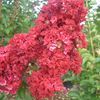
|
Crape Myrtle, Red RocketBotanical Name: Lagerstroemia indica 'Red Rocket'
Lagerstroemia is a genus with over 50 species and numerous cultivars to offer trees, shrubs, and weeping shrubs that can be utilized for just about any purpose in the landscape. Crape Myrtles are primarily grown for their long-lasting blooms – up to 120 days! Most species also have a smooth bark that sheds thin layers throughout the year, uncovering inner bark that is shades of gray or even cinnamon-red. 'Red Rocket' is an improved powdery mildew resistance cultivar with rich red blooms. Flowers begin to emerge in the early summer after foliage, in panicles of crinkled small flowers with a crepe-like feel and look. They last longer if the plant is not terribly overwatered. When the blooms finally being to drop, they are followed by a large number of capsule fruits that can weigh down the branches. If it’s still early in the ear, prune the fruits to promote another round of flowering. If untrimmed, the large green fruits will dry out, turning into black husk that split open to release numerous small seeds. Blooms only appear on new branches, so it’s not uncommon to prune them in the winter. Unfortunately, larger specimens are often butchered back severely to encourage additional branches and many more blooms. Since most crape myrtles recover nicely, they are routinely victimized by those without taste. Simple opposite green leaves emerge early in the spring, and vary in size according to the cultivar. They turn a lovely shade of red, orange, or yellow in the fall. Crape Myrtles appreciate moist soils, but tolerate dry conditions once they are established. [ More Info ]
|
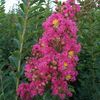
|
Crape Myrtle, TuscaroraBotanical Name: Lagerstroemia indica 'Tuscarora'
Lagerstroemia is a genus with over 50 species and numerous cultivars to offer trees, shrubs, and weeping shrubs that can be utilized for just about any purpose in the landscape. Crape Myrtles are primarily grown for their long-lasting blooms – up to 120 days! Most species also have a smooth bark that sheds thin layers throughout the year, uncovering inner bark that is shades of gray or even cinnamon-red. 'Tuscarora' is an improved powdery mildew resistance cultivar with light red blooms, often used in leu of Watermelon Red. Flowers begin to emerge in the early summer after foliage, in panicles of crinkled small flowers with a crepe-like feel and look. They last longer if the plant is not terribly overwatered. When the blooms finally being to drop, they are followed by a large number of capsule fruits that can weigh down the branches. If it’s still early in the ear, prune the fruits to promote another round of flowering. If untrimmed, the large green fruits will dry out, turning into black husk that split open to release numerous small seeds. Blooms only appear on new branches, so it’s not uncommon to prune them in the winter. Unfortunately, larger specimens are often butchered back severely to encourage additional branches and many more blooms. Since most crape myrtles recover nicely, they are routinely victimized by those without taste. Simple opposite green leaves emerge early in the spring, and vary in size according to the cultivar. They turn a lovely shade of red, orange, or yellow in the fall. Crape Myrtles appreciate moist soils, but tolerate dry conditions once they are established. [ More Info ]
|
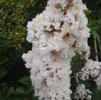
|
Crape Myrtle, WhiteBotanical Name: Lagerstroemia indica
Lagerstroemia is a genus with over 50 species and numerous cultivars to offer trees, shrubs, and weeping shrubs that can be utilized for just about any purpose in the landscape. Crape Myrtles are primarily grown for their long-lasting blooms – up to 120 days! Most species also have a smooth bark that sheds thin layers throughout the year, uncovering inner bark that is shades of gray or even cinnamon-red. Flowers begin to emerge in the early summer after foliage, in panicles of crinkled small flowers with a crepe-like feel and look. They last longer if the plant is not terribly overwatered. When the blooms finally being to drop, they are followed by a large number of capsule fruits that can weigh down the branches. If it’s still early in the ear, prune the fruits to promote another round of flowering. If untrimmed, the large green fruits will dry out, turning into black husk that split open to release numerous small seeds. Blooms only appear on new branches, so it’s not uncommon to prune them in the winter. Unfortunately, larger specimens are often butchered back severely to encourage additional branches and many more blooms. Since most crape myrtles recover nicely, they are routinely victimized by those without taste. Simple opposite green leaves emerge early in the spring, and vary in size according to the cultivar. They turn a lovely shade of red, orange, or yellow in the fall. Crape Myrtles appreciate moist soils, but tolerate dry conditions once they are established.
[ More Info ]
|

|
CrossvineBotanical Name: Bignonia capreolata 'Tangerine Beauty'
A Texas native semi-evergreen vine that climbs fences, trellises, and trees easily with its small tendrils. It can reach lengths up to 40 feet, easily attracting hummingbirds and butterflies throughout the blooming season. 'Tangerine Beauty' is a cultivar reintroduced by J.C. Ralston of the University of North Carolina. The flowers are borne in clusters, each being pinkish-red with an orange-yellow throat. The bright green leaves turn an attractive red to purple hue in the winter after the first cold front. . Crossvine is somewhat drought and poor soil tolerant, exhibiting no pest issues. [ More Info ]
|
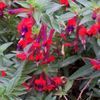
|
Cuphea, Bat FaceBotanical Name: Cuphea llavea
Small mounding perennial native to Mexico that attracts hummingbirds and butterflies easily. Produces a multitude of 1" red tubular flowers with purple throats open at the end with small patterns of a bat (hence the name) [ More Info ]
|
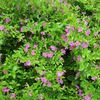
|
Cuphea, Dwarf Mexican HeatherBotanical Name: Cuphea hyssopifolia
Quick growing Mexican native perennial that reaches only twelve inches tall and wide returning in the spring if mulched heavily. Small attractive purple flowers appear in the early summer that stay till winter. Attracts bees and butterflies easily. [ More Info ]
|
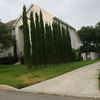
|
Cypress, ItalianBotanical Name: Cupressus sempervirens
A species of cypress that is native to the Mediterranean which distinctively stands out with its very tall and narrow growth habit. It requires unique placement in any landscape, getting no more than a few feet wide yet up to 40 feet tall. The erect branches do not branch far out from the main trunk, and have scale-like leaves produced off shoots of the branches. The dense, dark green leaves hold their color year round; in colder climates to the north the tree forms a narrow cone-shape. The seed cones are not readily visible when mixed in with the leaves. Requires well drained soils, and appreciates regular watering and fertilization. [ More Info ]
|
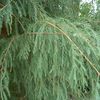
|
Cypress, MontezumaBotanical Name: Taxodium mucronatum
Native to Mexico and the Rio Grande area of Texas, Montezuma Cypress is also known as Sabino or Ahuehuete; it is the national tree of Mexico. There is a specimen called “Tule” in Santa Maria that is estimated to be 2,000 years old. Montezuma Cypress tree is an ideal substitute for the Bald Cypress, as it holds onto its leaves better during cold weather. In warmer areas of Southern Texas, it remains evergreen. Extremely versatile as it thrives in river beds and standing water, it tolerates drought like conditions anywhere in Texas. When grown in standing water, it produces “knees” that are characteristic of the Taxodium cypresses. They are often staked when cultivated in the nursery industry, as they are fast growing and the wood is weak when young. The branches have a natural weeping habit to them, and have pinnately arranged flat leaves that are needle-like, looking very delicate from a distance. The tree forms a broad spreading crown. The bark is brown to tan in color, with slight shredded-like exfoliation. [ More Info ]
|
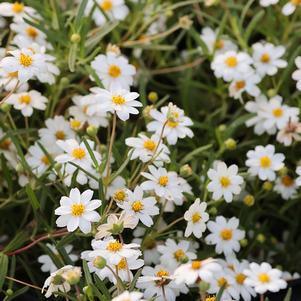
|
Daisy, Black FootBotanical Name: Melampodium leucanthum
Texas native mounding perennial with an abundance of small white flowers throughout the warm season. Grows up to twelve inches tall and wide. Easily self propigates by seed becoming a massing in a couple years.
The white flower petals surround a small yellow senter, reaching only one inch total in width. Attracts bees, butterflies, and birds easily. Must be provided well draining soils; blooms best in full sun.
[ More Info ]
|
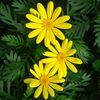
|
Daisy, BushBotanical Name: Gamolepis chrysanthemoides
Evergreen shrub-forming perennial that grows up to six feet tall and four feet wide. Gray-green to green foliage is complimented by the yellow daisy-like flowers that persist until winter.
[ More Info ]
|
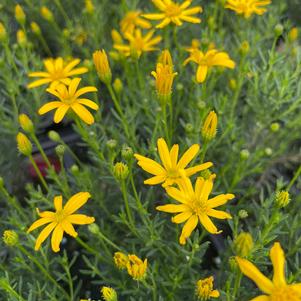
|
DamianitaBotanical Name: Chrysactinia mexicana
Chrysactinia mexicana, also known as Damianita or False Damiana, is a charming and resilient perennial shrub native to the southwestern United States and northern Mexico. With its small, evergreen leaves and abundant clusters of daisy-like golden-yellow flowers, it brings a burst of color and cheer to arid landscapes. Its compact growth habit, reaching no more than 2 feet in height and spread, makes it well-suited for borders, rock gardens, and containers, adding a touch of brightness to even the smallest spaces. This drought-tolerant and heat-loving plant thrives in full sun and well-drained soil, making it an ideal choice for xeriscaping projects or water-wise gardens. Its aromatic foliage releases a pleasant fragrance when brushed against, further enhancing its appeal in the landscape. Additionally, Chrysactinia mexicana attracts pollinators like bees and butterflies, contributing to the biodiversity of the garden ecosystem. The fragrance also deters deer from consuming it. Low-maintenance and resilient, Damianita requires little care once established, thriving in hot, dry conditions without the need for frequent watering or fertilization. Pruning after flowering helps maintain its compact shape and encourages continued blooming. [ More Info ]
|
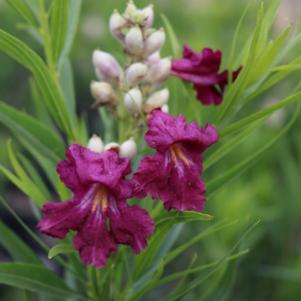
|
Desert Willow, 'Sweet Bubba'Botanical Name: Chilopsis linearis 'Sweet Bubba'
'Sweet Bubba' is a cultivated variety of the Chilopsis linearis plant, commonly known as desert willow. The 'Sweet Bubba' cultivar is primarily known for its ornamental value. It features attractive, trumpet-shaped flowers that bloom during the summer months, creating a stunning display of color. The flowers of 'Sweet Bubba' are dark burgundy, and are quite abundant and appear in clusters, adding a vibrant touch to any landscape. Easily attracts pollinators such as hummingbirds and bees. In addition to its beautiful flowers, 'Sweet Bubba' also possesses slender, willow-like leaves that are green and elongated. These leaves add an elegant and graceful element to the tree's overall appearance. During the autumn season, the foliage of 'Sweet Bubba' turns yellow, providing a final burst of color before the leaves drop. One of the notable attributes of Desert Willow is its adaptability to various growing conditions. It is particularly well-suited for arid and semi-arid regions, thriving in dry, desert-like environments. This makes it a popular choice for gardens and landscapes in many areas of Texas. It prefers well-drained soil and full sun exposure for optimal growth and flowering. While it can tolerate a range of soil types, it thrives in sandy or loamy soils. [ More Info ]
|
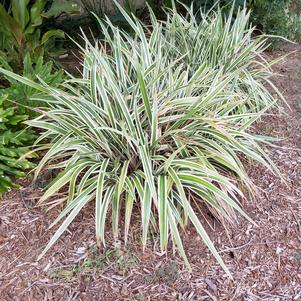
|
Dianella, Variegated Flax LilyBotanical Name: Dianella tasmanica 'Variegata'
Variegated form of Flax Lily. The olive green leaves have outer stripes of light green foliage, providing a striking contrast in any flowerbed. Clump forming habit makes it ideal for borders or massings. Small blue flowers appear in the spring, followed by small dark blue berry fruits that are reportedly poisonous. Can tolerate full sun, however thrives in morning sun and filtered afternoon shade. Once established, is somewhat drought tolerant. [ More Info ]
|
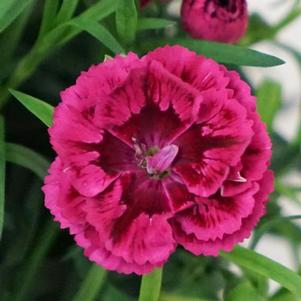
|
DianthusBotanical Name: Dianthus caryophyllus 'DiaDeur™ Pink+Red Dianthus'
DiaDuer Pink & Red Dianthus from Ball Seed is a remarkable variety of the Dianthus family, known for its ability to withstand cold temperatures down to 10 degrees Fahrenheit. This cold-hardy plant not only adds beauty to your garden but also attracts essential pollinators like bees and butterflies, contributing to the local ecosystem. To ensure its health and vibrancy, regular fertilization is recommended. This Dianthus variety favors morning sun and afternoon dappled shade. Its striking multicolored blooms, combining vivid red and pink hues, make it an eye-catching addition to gardens and containers. With a mature size of 14" by 12", it's a perfect fit for container gardening and small spaces. Furthermore, its versatility extends to indoor cultivation, allowing you to bring it inside during freezing weather, providing a practical solution for the unpredictability of our Texas climate.
[ More Info ]
|
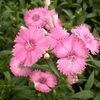
|
DianthusBotanical Name: Dianthus chinensis
Easy annual that does well in hot weather. Stiff upright stems that branch repeatedly, topped with flat clusters of single or double flowers in red, pink, white, or bicolors. No maintenance needed. [ More Info ]
|
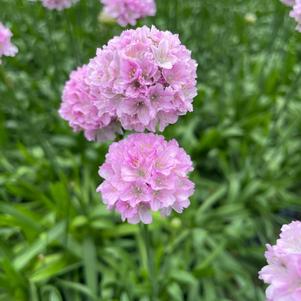
|
Dreameria Sweet Dreams ThriftBotanical Name: Armeria pseudarmeria 'Sweet Dreams'
Compact perennial with tidy growth habit and eye catching flowers on stems that reach above the plant. Easily attracts butterflies and shows tolerance to deer, heat, and light frost. Will bloom early spring to frost and ideal for small flower beds or container plantings. Performs best when old flowers are trimmed off, which is simple due to the tall stems that reach above the foliage. Performs best in a sunny location with well drained soils. Avoid overwatering. [ More Info ]
|
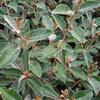
|
Elaeagnus or SilverberyBotanical Name: Elaeagnus pungens
This Chinese / Japanese native shrub can be found in the in some of the most unfruitful places due to its tough and durable nature to grow just about anywhere in Texas. This evergreen shrub sends out pointed branch stems from the base, often several feet before branching off or putting out new leaves. Leaves are oval shaped, up to four inches long and slightly wavy. They are green on top with brown scales, and lighter green with silver flecks on the bottom. They are not smooth to the touch, and hardly plain to look at. Bell shaped flowers in the fall are barely noticeable by sight, but easily acknowledged by the strong scent. The flowers turn to berries shortly after, and are food for birds early into the winter. Elaeagnus can be a nice, tightly trimmed hedge with a uniform shape, but will require constant pruning of the branches that emerge. It will grow in any soil condition except poorly drained soils, and tolerates heat and drought nearly like no other shrub. [ More Info ]
|
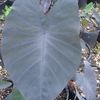
|
Elephant EarBotanical Name: Colocasia esculenta 'Black Magic'
Fast growing herbaceous perennial with heart-shaped leaves reaching up to 2-3 feet in length and 1-2 feet in width. Grows fine in standing water or poorly drained soils; responds very well to regular fertilization. Requires more water if grown in full sun. A gorgeous ornamental with many cultivars available on the market. 'Black Magic' cultivar has purplish-black leaves that turn a dullish green in the heat of the summer. Colocasia dies back in colder climates and will return if the corms do not dry out. [ More Info ]
|
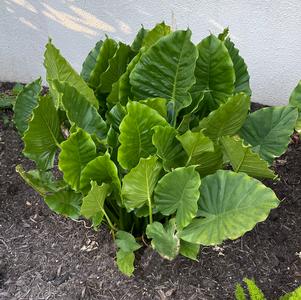
|
Elephant EarBotanical Name: Alocasia sp.
Fast growing herbaceous perennial with large heart-shaped leaves reaching up to 3-6 feet in length and 3-6 feet in width. Grows fine in standing water or poorly drained soils; responds very well to regular fertilization. Requires more water if grown in full sun. A gorgeous ornamental with many cultivars available on the market. Colocasia dies back in colder climates and will return if the corms do not dry out. [ More Info ]
|
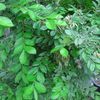
|
Elm, CedarBotanical Name: Ulmus crassifolia
Cedar Elm is the most common of the Texas native elms, and most resistant to Dutch Elm Disease. It’s found in East Texas, thriving in the deep rich soils along riverbanks and lakes. It is highly adaptable to dry and hot places throughout Texas and ideal for any landscape with adequate drainage. The coarse small green leaves emerge bright green, but mature to a darker green, turning yellow in the fall. They are up to two inches long with a coarse toothed margin on the edges. The branches have a flat cork ridge on both sides. Red-brown to red-green flowers in the fall are not very noticeable, and are wind pollinated. The slightly hairy winged samara fruits are often abundant, and fall with the leaves in the winter. The tree itself is maintenance free and tolerant of many adverse conditions, however be aware the seeds easily germinate; pulling up or mowing down saplings may become a regular chore. [ More Info ]
|
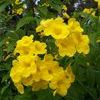
|
Esperanza, DwarfBotanical Name: Tecoma stans 'Nana'
Dwarf cultivar of the popular blooming perennial shrub native to Texas and Mexico. Bright green leaves are complimented with the multitude of yellow trumpet shape flowers appearing on the new growth from spring to fall. Esperanza is a tough and hardy plant ideal for any Texas landscape. It appreciates well-drained soils despite the quality it's grown in. Pruning is not necessary till the first frost when the entire plant is killed back to the ground; good mulching will allow the roots to survive and return in the spring with vigor. In north Texas, it is treated as an annual. Member of the Plants for Texas program. [ More Info ]
|
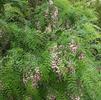
|
Eve's NecklaceBotanical Name: Styphnolobium affine
Eve’s Necklace is native to north-central Texas to the Edwards Plateau. It’s an ideal small tree for any landscape as it performs well as an understory or a small tree providing filtered shade to flower beds below. When grown in the shade, branches shoot upwards nearly vine line through other trees and shrubs in bid for sunlight. In full sun, it forms an irregular upright oval crown. It responds well to pruning, allowing the homeowner to guide the preferred shape. Towards the middle of spring, fragrant cascading rose-pink flowers will hang in clusters for two to three weeks. They are followed by black seed pods, up to six inches long, that dry and persist into the winter. The seed pods give the plant its name, as they look like black beads on a string. The pinnately compound leaves are slightly glossy green, but provide no fall color. The delicate foliage combined with the arching habit of the branches give the tree an overall fragile demeanor. Once established, Eve’s necklace is drought tolerant and exhibits no pest or disease issues. [ More Info ]
|

|
Evergold SedgeBotanical Name: Carex hachijoensis
Evergreen variegated clump forming grass that stays at an easily manageable size, while remaining maintenance and pest free once established in the landscape. Greenish flowers blend in with the leaves, Ideal for grassy borders or mass plantings. Grown from tissue culture as it does NOT reseed and become a pest. [ More Info ]
|
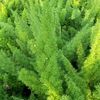
|
Fern, FoxtailBotanical Name: Asparagus densiflorus 'Meyerii'
Semi-hardy herbaceous perennial with arching, feather stems that form a dense frond with a open 'fluffy' look that resembles a fox's tail. Ideal for containers to relocate in the winter to protect from freezing temperatures. Small white flowers start to appear in the late spring and summer, followed by bright red berries with seeds instead of spores which disqualifies this plant as a true fern. [ More Info ]
|
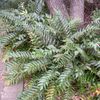
|
Fern, HollyBotanical Name: Cyrtomium falcatum
Holly Fern is an evergreen fern that brings elegance and vibrancy to shaded gardens and landscapes. With its glossy, dark green fronds resembling holly leaves, this popular fern species adds a touch of sophistication to any setting. Growing in a compact rosette shape and reaching a moderate height of 1 to 2 feet, Holly Fern is well-suited for various garden arrangements. Thriving in partial shade or shaded locations, Holly Fern is an ideal choice for areas with limited direct sunlight. Its glossy fronds not only enhance its visual appeal but also create interesting interplay with light in shaded environments. This fern prefers moist, well-draining soil and can adapt to different soil types, such as loamy, sandy, or clay soils. Regular watering is important to maintain soil moisture, while avoiding overwatering to prevent root rot. Versatile in landscaping, Holly Fern can be used as a striking standalone specimen or planted in groups to add texture and visual interest to shaded gardens or woodland settings. It can also function as an attractive groundcover, filling bare patches with its lush, green foliage. With low maintenance requirements, Holly Fern is an excellent choice for those seeking an elegant and resilient fern species that thrives in shaded conditions. [ More Info ]
|

|
Fern, RiverBotanical Name: Dryopteris normalis
Fast growing Texas native fern that demands moist, well drained acidic soils throughout the spring and summer. Semi-evergreen in warmer areas, but dies back to the roots completely if temperatures drop below freezing. Leaves are a light green hue, very graceful and delicate. Spreads easily by underground runners. Although it is drought tolerant, it dies back to the roots and will only return during wet conditions. Will outright die within twelve months if the conditions do not become favorable.
[ More Info ]
|
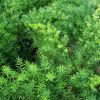
|
Fern, SprengeriBotanical Name: Asparagus densiflorus 'Sprengeri'
Open airy leaves and the light graceful form gave this plant it's name, however it is not a true fern as it self propagates by seeds and root stems. Small white flowers appear in the summer, followed by red berries that are enjoyed by birds. Turns an unsightly shade of yellow in the heat of full sun, however maintains a healthy dark green in shade. [ More Info ]
|
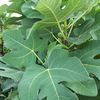
|
Fig TreeBotanical Name: Ficus carica 'Celeste'
A popular fruit tree for Texas that grows well in the ground or in containers. The tree sap is milky and irritating to the skin. Not ideal for small landscapes, as it can feasilbly grow 40' feel tall and wide and block out sunlight to any plants under it. Fig trees normally put out two crops - the Breba Crop and Main Crop. The Breba Crop is the first, with fruits appearing in the spring on last seasons' new growth. The Main Crop comes in the fall on that seasons' new growth. Growth as mentioned can get quite overbearing, and loss of fruits is likely if pruned heavily. Water young fig trees regularly till established. Thereafter, provide a deep watering every one or two weeks. Fig Trees benefit from heavy mulching, which retains the soil moisture. [ More Info ]
|

|
Fig VineBotanical Name: Ficus pumila
A vigorous growing vine native to East Asia that has found itself useful in the southern Texas landscapes. Two types of leaves exist for the Fig Vine; the young leaves are small, no larger than one inch and are borne on young stems that do nothing more than climb any surface they touch. This, coupled with the vigorous growth habit allow Fig Vine to cover walls, trees, and even buildings relatively quickly and completely. Once the vine finds it has nothing left to climb, adult stems will emerge with larger, thicker leaves, and will also bear non-edible fig fruits. Fig Vine is very tolerant of poor soil and heat. Harsh winters can kill the vine back; otherwise pruning it constantly to keep under control will be required. Be aware of the surfaces it will come into contact with, as it will damage wood fences and brick walls if forcefully removed. If you wish to remove Fig Vine with minimal damage, destroy the plant or stems at the base and allow the foliage to decompose naturally. [ More Info ]
|
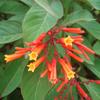
|
FirebushBotanical Name: Hamelia patens
Central American native shrub that has adapted perfectly for central to south Texas. Fast growing semi-evergreen shrub with very showy terminal clusters of red-orange tubular flowers that easily attract hummingbirds and butterflies. Small juicy red fruits in the fall attract birds. Grows best in full sun; becomes uniniformed and blooms less in the shaded enviroments. Requires well drained soils, and performs best with regular watering but will tolerate drought conditions. An excellent perennial for central Texas, and annual to the north. No pest or disease problems. A member of the Plants for Texas program. [ More Info ]
|
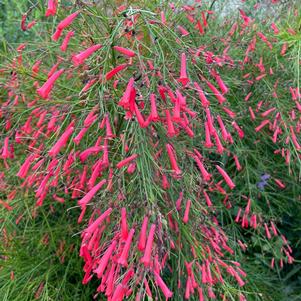
|
Firecracker FernBotanical Name: Russelia equisetiformis
Semi-evergreen perennial with clusters of scarlet tubular blooms from spring to fall. They form on the new growth of slender stems that gracefully fall over as they grow upwards, almost a fern growth habit. Appreciates regular watering and good drainage. [ More Info ]
|
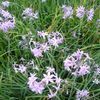
|
Garlic (Society)Botanical Name: Tulbaghia violacea
Aromatic perennial with a strong garlic-onion fragrance. Purple blooms persist spring to fall, reaching up to three feet tall.
[ More Info ]
|
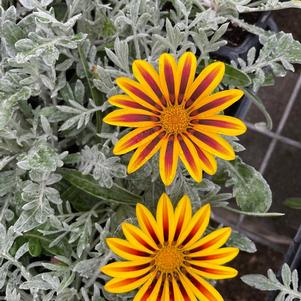
|
GazaniaBotanical Name: Gazania rigens
New for 2022, this perennial flower boast vibrant flowers that thrive in hot and dry enviroments. Cultivars for 2022 Kiss Frosty Mix - green foliage with multiple large white blooms with red and yellow streaks. [ More Info ]
|
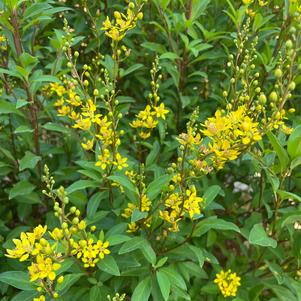
|
Golden ThryallisBotanical Name: Galphimia glauca 'Rain of Gold'
Thryallis is a captivating and ornamental shrub that boasts an eye-catching display of golden flowers. Native to Mexico, this cultivar is renowned for its vibrant blossoms, which resemble a shower of radiant gold when in full bloom. The plant features small, glossy green leaves that provide an attractive backdrop to the profusion of bright yellow flowers. 'Rain of Gold' is a compact and low-maintenance shrub, making it a popular choice for garden enthusiasts seeking a splash of color and visual appeal. This particular variety is known for its versatility and adaptability to different growing conditions. It thrives in full sun to partial shade and is highly tolerant of heat and drought. 'Rain of Gold' can reach a height of around 3 to 4 feet with a similar spread, making it suitable for various garden settings, including borders, containers, or as a standout accent plant. Its long blooming period, typically spanning from spring to fall, ensures a prolonged showcase of its radiant golden flowers, attracting pollinators like bees and butterflies to the garden. It will die back to the ground in the winter if it reaches mid 20s, but if mulched well it will return in the spring. [ More Info ]
|
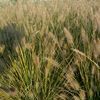
|
Grass, Dwarf HamelnBotanical Name: Pennisetum alopecuroides 'Hameln'
Hameln, also ‘Fountain Grass’, is a small perennial ornamental grass with a mounded growth habit that makes it ideal for small borders, mass plantings, and erosion control. The rich green leaves turn golden yellow in fall when green-white flower plumes appear and persist until the first freeze. Requires well drained soils, and will suffer if left in areas with standing water. It is not required, however it’s recommended to cut back all dead foliage before spring solely for aesthetic reasons. [ More Info ]
|
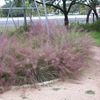
|
Grass, Gulf MuhlyBotanical Name: Muhlenbergia capillaris 'Regal Mist'
Texas native dwarf ornamental clumping grass with glossy green foliage that becomes nearly hidden under the very attractive pink-red flowers in the late summer that almost become a haze over the entire plant, lasting up to a month. An outstanding choice for massings. Will grow back after a freeze and return in the spring. Require well drained soils, and will suffer if left in areas with standing water. It is not required, however it’s recommended to cut back all dead foliage before spring solely for aesthetic reasons. [ More Info ]
|
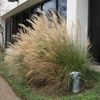
|
Grass, MuhlyBotanical Name: Muhlenbergia lindheimeri
Texas native clump forming grass that is an ideal choice for an accent or summer screen. The blue-green leaves compliment the flower plumes that emerge slightly purple, then turning silvery-gray. Lindheimer is a fast grower and could possibily benefit from a pruning in early August before blooming, but not neccessary. Requires well drained soils, and will suffer if left in areas with standing water. It is not required, however it’s recommended to cut back all dead foliage before spring solely for aesthetic reasons. [ More Info ]
|
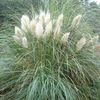
|
Grass, Pampas DwarfBotanical Name: Cortaderia selloana 'Pumila'
Dwarf cultivar of Pampas grass that doesn’t become as overbearing or invasive as the regular Pampass. An excellent large barrier as the foliage is sharp enough to cut skin. Large plumes are striking in the fall and persist into winter. Pampass is one of the toughest ornamental grasses available, and nearly considered evergreen. Require well drained soils, and will suffer if left in areas with standing water. It is not required, however it’s recommended to cut back all dead foliage before spring solely for aesthetic reasons. [ More Info ]
|
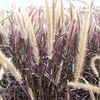
|
Grass, Purple FountainBotanical Name: Pennisetum setaceum 'Atrosanguineum'
Clumping perennial grass with outstanding purple foliage throught the warm season, and pinkish-purple flowers in the fall. Will die in a freeze; often treated as an annual.
[ More Info ]
|

|
Green Flax LilyBotanical Name: Dianella tasmanica
The olive green leaves are smaller than the variegated cultivar,and , provides a solid green small baririer or mass planting. Small blue flowers appear in the spring, followed by small dark blue berry fruits that are reportedly poisonous. Can tolerate full sun, however thrives in morning sun and filtered afternoon shade. Once established, is somewhat drought tolerant. [ More Info ]
|
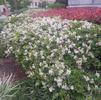
|
Hawthorn, Snow WhiteBotanical Name: Raphiolepis indica 'Snow White'
Native to southern China, Indian Hawthorn is a popular landscape shrub due to the natural ability to stay at a manageable size, spring blooms, and attractive berries in the fall. If there was any drawback to the hawthorns, it would be that deer prefer them to any other plant when dining in everyone’s backyard. ‘Snow White’ forms a natural mound shape, no more than three feet tall. Indian Hawthorn leaves are alternate and leathery to the touch, with serrated margins. ‘Snow White’ is a cultivar with leaves that start red to burgundy, turning dark green within a month. Flowers in the spring are white, no more than ¾” in diameter and appearing in large clusters. Pome fruits that follow in the fall are dark purple to black, attracting birds. Hawthorns prefer well drained soils, and can tolerate poor quality soil and even drought once established. [ More Info ]
|

|
Hibiscus, OrangeBotanical Name: Hibiscus rosa-sinensis
[ More Info ]
|

|
Hibiscus, RedBotanical Name: Hibiscus rosa-sinensis
[ More Info ]
|

|
Hibiscus, YellowBotanical Name: Hibiscus rosa-sinensis
[ More Info ]
|
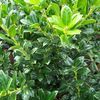
|
Holly, Burford DwarfBotanical Name: Ilex cornuta 'Burfordii Nana'
For almost any landscape need, there is a cultivar or hybrid of The Chinese Holly (Ilex Cornuta) to satisfy it. Hollies prefer acidic fertile moist and well drained soils, but they adapt to the adverse condtions, including poorly drained soils. Young stems are yellow-green, turning silver-gray as they mature. The Chinese hollies are dioecious, with small yellow-white flowers in the late spring and early summer, somewhat noticeable. Later in the fall they will develop highly ornamental red drupe berries in clusters that normally persist into the winter providing food for birds. These hollies have alternate simple leaves that are elliptical and feel like plastic; they will have at least one spine, and possibly up to several along leave margins. ‘Burfordii nana’ is a dwarf cultivar of the Burfordii, averaging only six feet in height, not often up to eight feet. Makes an excellent medium border or hedge. The berry fruits in the fall aren’t as abundant either. The leaves have a sharp spine on the tip, and roughly half the leaves will have two spines along the sides. [ More Info ]
|
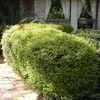
|
Holly, Dwarf YauponBotanical Name: Ilex vomitoria 'Nana'
Native to Texas, Yaupon Holly is a species of holly that tolerates the hot and dry Texas summers with relative ease, however prospers when provided more ideal conditions. Yaupons include evergreen shrubs or small trees with light gray bark, and small oval shaped alternate leaves with coarsely serrated margins. It forms multiple stems in clumps, giving the plant some density despite the smaller leaves. ‘Nana’ is a dwarf cultivar of Yaupon Holly, never growing over five feet in height or width. It’s often trimmed into hedges or shaped into topiary balls in the landscape. The small white flowers in the spring are somewhat striking. The red drupe berries common with Yaupon are not as noticeable with ‘Nana’. They stay on during the winter, attracting birds and other wildlife as a food source. Ilex vomitoria received its name from its usage with Native Americans; it was an ingredient in teas used in rituals that would induce vomiting. Yaupon tolerates nearly any quality type of soil, and can be grown along the coastline as well. [ More Info ]
|
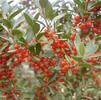
|
Holly, Native YauponBotanical Name: Ilex vomitoria
Native to Texas, Yaupon Holly is a species of holly that tolerates the hot and dry Texas summers with relative ease, however prospers when provided more ideal conditions. Yaupons include evergreen shrubs or small trees with light gray bark, and small oval shaped alternate leaves with coarsely serrated margins. It forms multiple stems in clumps, giving the plant some density despite the smaller leaves. The small white flowers in the spring are somewhat striking; however the red drupe berries that follow in the fall to winter are the main attraction. They stay on during the winter, attracting birds and other wildlife as a food source. Ilex vomitoria received its name from its usage with Native Americans; it was an ingredient in teas used in rituals that would induce vomiting. Yaupon tolerates nearly any quality type of soil, and can be grown along the coastline as well. [ More Info ]
|
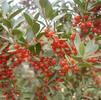
|
Holly, Native Yaupon (Pyramid)Botanical Name: Ilex vomitoria
Native to Texas, Yaupon Holly is a species of holly that tolerates the hot and dry Texas summers with relative ease, however prospers when provided more ideal conditions. Yaupons include evergreen shrubs or small trees with light gray bark, and small oval shaped alternate leaves with coarsely serrated margins. It forms multiple stems in clumps, giving the plant some density despite the smaller leaves. The small white flowers in the spring are somewhat striking; however the red drupe berries that follow in the fall to winter are the main attraction. They stay on during the winter, attracting birds and other wildlife as a food source. Ilex vomitoria received its name from its usage with Native Americans; it was an ingredient in teas used in rituals that would induce vomiting. Yaupon tolerates nearly any quality type of soil, and can be grown along the coastline as well. [ More Info ]
|
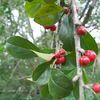
|
Holly, Possom Haw YauponBotanical Name: Ilex decidua 'Warren's Red'
Breaking the mold of spiny, evergreen hollies is Ilex decidua, or Possomhaw – a deciduous Holly. Possomhaw has a very upright growth habit when young, reaching up several feet before spreading out. Glossy dark green leaves cover this large shrub or small tree in the summer, turn yellow before falling off in the early winter. Small white flowers are inconspicuous in the spring – and require a male Ilex decidua or opaca nearby to pollinate. If pollinated, they produce a large quantity of orange-red drupe berries common to the Hollies, that contract beautifully in the winter against the silver-grey bark. ‘Warren’s Red’ is an all-female cultivar that has the most quantitative berry load of the deciduous hollies. Best used in the landscape as a specimen or even providing summer shade against the house. Native to the wetlands of North America, Possomhaw adapts to poor soils conditions and is drought tolerant once established. [ More Info ]
|
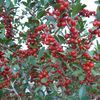
|
Holly, Pride of Houston YauponBotanical Name: Ilex vomitoria 'Pride of Houston'
Native to Texas, Yaupon Holly is a species of holly that tolerates the hot and dry Texas summers with relative ease, however prospers when provided more ideal conditions. Yaupons include evergreen shrubs or small trees with light gray bark, and small oval shaped alternate leaves with coarsely serrated margins. It forms multiple stems in clumps, giving the plant some density despite the smaller leaves. The small white flowers in the spring are somewhat striking; however the red drupe berries that follow in the fall to winter are the main attraction. They stay on during the winter, attracting birds and other wildlife as a food source. ‘Pride of Houston’ Yaupon is an all-female cultivar, guaranteeing berries every season. Ilex vomitoria received its name from its usage with Native Americans; it was an ingredient in teas used in rituals that would induce vomiting. Yaupon tolerates nearly any quality type of soil, and can be grown along the coastline as well. [ More Info ]
|
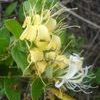
|
Honeysuckle, HallsBotanical Name: Lonicera japonica 'Halliana'
A vigorous semi-evergreen that is not only used as a vine or groundcover, but can be trimmed into a hedge. It should be segregated from other shrubs or small trees as it can rapidly cover them.
Hall's Honesuckle grows up to 15 feet in length and bears fragrant yellow-white flowers throughout the warm seasons, attracting butterflies. It will grow in the shade, but will not flower.
Tolerant of poor soils and drought, coupled with rapid growth habit make this honeysuckle an ideal choice for mass plantings on banks and slopes for controlling erosion. In the landscape, it tolerates heavy pruning (even mowing) in the fall to keep under control.
[ More Info ]
|
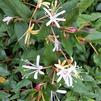
|
Honeysuckle, PurpleBotanical Name: Lonicera japonica 'Purpurea'
A vigorous semi-evergreen that is used as a vine or groundcover. It should be segregated from other shrubs or small trees as it can rapidly cover them.
'Purpureae' grows up to 15 feet in length and bears fragrant purplish-red and white flowers throughout the warm seasons, attracting butterflies. It will grow in the shade, but will not flower. The leaves are a dark green to purple-green on top, with a purple hue underneath.
Tolerant of poor soils and drought, coupled with rapid growth habit make this honeysuckle an ideal choice for mass plantings on banks and slopes for controlling erosion. In the landscape, it tolerates heavy pruning (even mowing) in the fall to keep under control.
[ More Info ]
|

|
ImpatiensBotanical Name: Impatiens wallerana
Impatiens walleriana 'Imara XDR' represents a resilient and vibrant addition to garden landscapes, renowned for its exceptional disease resistance. This cultivar of the popular impatiens species offers a diverse array of colors and compact growth habit, making it ideal for mass plantings, borders, or containers. 'Imara XDR' stands out for its ability to thrive in challenging environments, displaying remarkable resilience against downy mildew, a common affliction in impatiens. With its profusion of colorful blossoms in shades of pink, red, purple, and white, this cultivar provides continuous blooms throughout the growing season, even in shaded areas. Its low-maintenance nature and ability to withstand adverse conditions make it a preferred choice for both novice and experienced gardeners seeking reliable color and beauty in their landscapes.
Spring-Summer 2024 Imara XDR Proform Mix [ More Info ]
|
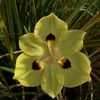
|
Iris, BicolorBotanical Name: Moraea bicolor
South Africa native clumping perennial with long, dark green strap leaves. Flower stems grow right above the leaves and produce yellow. Regular watering and fertilization encourage abundant flowers throughout the summer after the spring blooming period is past.
Dies back in cold winters to a rhizome; between this and the roots Bicolor Iris spreads easily by itself. Appreciates pruning in the winter when the leaves lose their color or outright die back. [ More Info ]
|
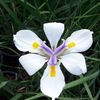
|
Iris, ButterflyBotanical Name: Moraea iridoides
South Africa native clumping perennial with long, dark green strap leaves that is also known as the African Iris. Flower stems grow right above the leaves and produce white flowers that have a small purple and yellow center. Regular watering and fertilization encourage abundant flowers throughout the summer after the spring blooming period is past. Dies back in cold winters to a rhizome; between this and the roots African Iris spreads easily by itself. Appreciates pruning in the winter when the leaves lose their color or outright die back. [ More Info ]
|
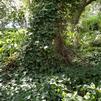
|
Ivy, EnglishBotanical Name: Hedera helix
An ideal ground cover or vine for shaded areas, English Ivy can climb walls and fences easily with its powerful clinging roots. Can easily become invasive due to the vigorous and low maintenance growth habit. Do not plant near areas that you wish to preserve the walls or surfaces to, as the airial roots can cause damage with removal.
English Ivy thrives in fertile loose soils, however easily dies from over watering or poor drainage. [ More Info ]
|

|
IxoraBotanical Name: Ixora coccinea
Dense tropical round-forming shrub popular for container plantings. Dark green oblong leaves sometimes hidden behind the large dense clusters of red-orange flowers that persist throughout the warm season; blooms best in full sun. Grows best in acidic soils with regular nitrogen fertilizer treatment. Pink and yellow blooming cultivars exist. [ More Info ]
|
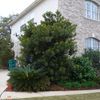
|
Japanese Blueberry ShrubBotanical Name: Elaeocarpus decipiens
Native to Japan, the Japanese Blueberry Tree is a fast grower that needs plenty of room in the landscape. It exhibits a dense growth habit, multiple branching with an upright form. It isn’t terribly cold hardy, but will survive south of Austin if mulch in the winters. New leaves emerge bronze, turning bright green before maturing dark green. Although evergreen, the older leaves will turn red and fall in the winter. Butterflies are easily attracted to the slightly fragrant greenish-white flowers that appear early in the summer, five-petaled and urn-shaped in racemes. Blue-black olive fruits mature in the fall, and are somewhat messy if planted near walkways. Blueberry tree prefers well-drained alkaline soils. It responds very well to pruning and is versatile when shaped into a topiary or tree form. [ More Info ]
|
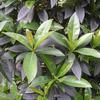
|
Japanese Blueberry Tree - Tree FormBotanical Name: Elaeocarpus decipiens
Native to Japan, the Japanese Blueberry Tree is a fast grower that needs plenty of room in the landscape. It exhibits a dense growth habit, multiple branching with an upright form. It isn’t terribly cold hardy, but will survive south of Austin if mulch in the winters. New leaves emerge bronze, turning bright green before maturing dark green. Although evergreen, the older leaves will turn red and fall in the winter. Butterflies are easily attracted to the slightly fragrant greenish-white flowers that appear early in the summer, five-petaled and urn-shaped in racemes. Blue-black olive fruits mature in the fall, and are somewhat messy if planted near walkways. Blueberry tree prefers well-drained alkaline soils. It responds very well to pruning and is versatile when shaped into a topiary or tree form. [ More Info ]
|
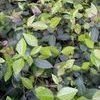
|
Jasmine, AsianBotanical Name: Trachelospermum asiaticum
Contrary to the name, this is not a true Jasmine. Native to Asia, it has become widespread in the landscape as it is the most common choice when it comes to ground covers.
Fast and vigorous growing, this evergreen tolerates heat and adverse conditions with no real pest issues. It will prefer and perform better in rich well-drained soils, but is drought tolerant once established. Spreads easily as the stems sprout roots when coming into contact with the ground, and often gets thick enough to prevent most weeds from growing.
Although many other sources claim there are yellow and highly fragrant blooms, it's rare to see in Texas.
[ More Info ]
|
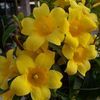
|
Jasmine, CarolinaBotanical Name: Gelsemium sempervirens
Native to the southeastern US, the Carolina Jasmine is a popular landscape choice despite all parts containing a toxin that can be fatal if consumed. This Jasmine grows best in the average homeowners landscape as it will grow only up to 20 feet, and responds will to regular pruning. Outstanding yellow trumpet shaped flowers appear early in the spring and persist for several weeks. Leaf spot is a common issue in wet months, so it is best planted in well ventilated and sunny areas. [ More Info ]
|
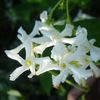
|
Jasmine, ConfederateBotanical Name: Trachelospermum jasminoides
Popular evergreen vine, also known as Star Jasmine, for the five petaled white flowers that are extremely fragrant, appearing in the spring. Climbs easily if grown near a lattice or trellis, otherwise will become a clumping groundcover spreading up to 20 feet.
[ More Info ]
|
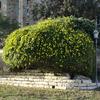
|
Jasmine, PrimroseBotanical Name: Jasminum mesnyi
Often used on highway medians, Primrose Jasmine is a fast growing, drought tolerant, and all-around tough shrub that needs its space in the landscape. It features an open sprawling habit, often growing wider than tall. When grown along fence lines and walls, it grows somewhat vine like, reaching greater heights. The green stems are square instead of round like most plants, with dark green glossy leaves divided into three leaflets. Primrose is best pruned in the winter – not only for removal of old foliage, but blooms will only appear on new growth. In the early spring the shrub is covered in slightly-fragrant yellow semi-double blooms that persist for a few weeks, sporadically until fall thereafter. The branches grow up to lengths of eight feet on average, and drape gracefully around the shrub to form a large thick mound. In moist and fertile areas, branch tips touching the ground will sprout roots, self propagating the shrub to even greater widths. Smaller landscapes will require Primose to be pruned regularly, whereas in large open areas it’s an excellent massing, border, or even erosion controller. [ More Info ]
|

|
Julia Child RoseBotanical Name: Rosa x 'Julia Child'
Highly disease resistant rose with golden double blooms with a licorice candy fragrance. Consistent bloomer, often with multiple flowers in tight clusters. The deep green foliage makes a striking contrast. Matures at three feet tall and wide, very low maintenance, making it an ideal choice for any landscape. [ More Info ]
|
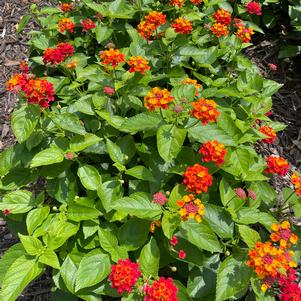
|
Lantana, Bandolista Red ChiliBotanical Name: Lantana sp. 'Red Chili'
Lantana 'Bandolista Red Chili' is a trademarked cultivar known for its striking and vibrant flower clusters. The flowers typically feature fiery shades of red, orange, and yellow, creating a captivating visual effect. This Lantana is a low-maintenance plant that is commonly used in gardens, landscapes, and containers. It is known for its ability to attract pollinators, such as butterflies and hummingbirds, with its nectar-rich flowers. It is generally considered a heat-tolerant and drought-resistant plant, making it suitable for warm and dry climates. It typically thrives in full sun and well-drained soil. With regular pruning, it can maintain a compact and bushy growth habit. "Bandolista Red Chili" is best described as a compact or ground cover "Radiation Lantana" [ More Info ]
|
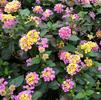
|
Lantana, ConfettiBotanical Name: Lantana sp.
Very durable Texas native that excels against adverse conditions with very few pest or disease issues. A prolific bloomer mid-summer to fall. Foliage is coarse and pungent when crushed. Will die back to the base in freezing temperatures and return in the spring. [ More Info ]
|

|
Lantana, Dallas RedBotanical Name: Lantana sp.
Very durable Texas native that excels against adverse conditions with very few pest or disease issues. A prolific bloomer mid-summer to fall. Foliage is coarse and pungent when crushed. Will die back to the base in freezing temperatures and return in the spring. [ More Info ]
|

|
Lantana, GoldBotanical Name: Lantana sp.
A popular herbaceous perennial found in all areas of Texas. A wide selection of cultivars to choose from, Lantana can be an ideal ground cover or shrub. Moderately fast growing, Lantana blooms early in the spring and continues until frost, attracting butterflies easily. Once establish, lantana is drought tolerant, relatively pest free, and low maintenance. New Gold Lantana is a sterile variety which will not produce berries, ensuring continuous blooming throughout the warm season. Reaching only an average of a foot high but several feet wide, it makes an ideal groundcover, erosion control, cover sides for raised beds, or even hanging baskets. [ More Info ]
|
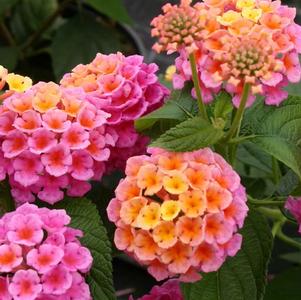
|
Lantana, Passion FruitBotanical Name: Lantana sp. 'Passion Fruit'
Lantana 'Passion Fruit' is a cultivar known for its striking and vibrant flower clusters. The flowers open a deep orange-yellow, and deepen through orange tones into deep fuchsia. This Lantana is a low-maintenance plant that is commonly used in gardens, landscapes, and containers. It is known for its ability to attract pollinators, such as butterflies and hummingbirds, with its nectar-rich flowers. It is generally considered a heat-tolerant and drought-resistant plant, making it suitable for warm and dry climates. It typically thrives in full sun and well-drained soil. With regular pruning, it can maintain a compact and bushy growth habit. [ More Info ]
|
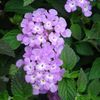
|
Lantana, PurpleBotanical Name: Lantana sp.
A popular herbaceous perennial found in all areas of Texas. A wide selection of cultivars to choose from, Lantana can be an ideal ground cover or shrub. Moderately fast growing, Lantana blooms early in the spring and continues until frost, attracting butterflies easily. Once establish, lantana is drought tolerant, relatively pest free, and low maintenance. Trailing Purple Lantana is a sterile variety which will not produce berries, ensuring continuous blooming. Unlike the White or Gold Lantana, Purple Lantana blooms better in the warmer winter over the hot summers. Reaching only an average of a foot high but several feet wide, it makes an ideal groundcover, erosion control, cover sides for raised beds, or even hanging baskets. [ More Info ]
|
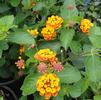
|
Lantana, RadiationBotanical Name: Lantana sp.
Lantana 'Radiation' is a cultivar known for its striking and vibrant flower clusters. The flowers typically feature fiery shades of red, orange, and yellow, creating a captivating visual effect. 'Radiation' is a low-maintenance plant that is commonly used in gardens, landscapes, and containers. It is known for its ability to attract pollinators, such as butterflies and hummingbirds, with its nectar-rich flowers. It is generally considered a heat-tolerant and drought-resistant plant, making it suitable for warm and dry climates. It typically thrives in full sun and well-drained soil. With regular pruning, it can maintain a compact and bushy growth habit. [ More Info ]
|
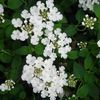
|
Lantana, WhiteBotanical Name: Lantana sp.
A popular herbaceous perennial found in all areas of Texas. A wide selection of cultivars to choose from, Lantana can be an ideal ground cover or shrub. Moderately fast growing, Lantana blooms early in the spring and continues until frost, attracting butterflies easily. Once establish, lantana is drought tolerant, relatively pest free, and low maintenance. Trailing White Lantana is a sterile variety which will not produce berries, ensuring continuous blooming throughout the warm season. Reaching only an average of a foot high but several feet wide, it makes an ideal groundcover, erosion control, cover sides for raised beds, or even hanging baskets. [ More Info ]
|
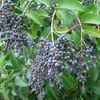
|
Ligustrum, JapaneseBotanical Name: Ligustrum lucidum
Native to Japan, this fast grower is recognized as a strong candidate for poor-soil and drought-prone landscapes. The dull-green leaves have a distinct pointed tip, and are arranged opposite on the stems that quickly shoot up from the base in several directions. Naturally forms an large open habit shrub, but is easily pruned into a small tree. It is not uncommon to find it pruned into topiary shapes, although Waxleaf Ligustrum would be a more ideal choice. Large clusters up to eight inches in length appear in the spring, bearing slightly fragrant white flowers. They are followed by green berries in the summer, turning dark blue to black for the winter. Birds feast on the berries, and then distribute the seeds across the area. Due to the ease of germination, Japanese Ligustrum spreads quickly. If planting in a row, remember Japanese Ligustrum can reach widths of 15 feet. Although drought tolerant, leaves will droop, but spring back after receiving water. No notable plant disease issues. [ More Info ]
|
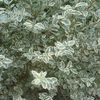
|
Ligustrum, Variegated PrivetBotanical Name: Ligustrum sinense 'Variegatum'
This quick growing cultivar of the Green Ligustrum has creamy white and green foliage, making an excellent choice for an accent plant or a distinctive hedge. Multiple stems form a somewhat thick clump, and are not adversely affected by regular pruning. The branches are thin and flexible, and will exhibit a slight weeping or fountain look when left unpruned at maturity. It is not uncommon for a few of the branches to revert back to being fully green, giving the impression two plants occupy the same space. Variegated Privit requires ample sunlight to maintain thick leaf cover; avoid planting in too much shade or next to plants or buildings that will subject it to full shade. Bright white flowers appear in the spring on new stems, and are somewhat visible against the foliage. Unnoticeable black fruits follow in the fall. No serious pest issues, but it can’t grow in wet or compacted soils. [ More Info ]
|

|
Ligustrum, WaxleafBotanical Name: Ligustrum japonicum 'Texanum'
Native to Japan, the Waxleaf Ligustrum is the most universally applied choice for a sculpted hedge plant in the Texas landscape; it is fast growing and not picky about when it is pruned. In addition to being pruned into hedges, it also can be pruned into a topiary, pyramidal form, or even a small tree. Highly fragrant panicles of white flowers appear in the late spring, and carry into the early summer. Small dull blue-black fruits develop in the fall, attracting birds easily. It differs from Japanese Ligustrum by having very glossy dark green leaves that easily snap when bent, and have no pointed tip. Once established, it’s very drought tolerant and grows well in urban or salty areas. 'Texanum' is a dwarf cultivar with a tighter growth habit, as well as reaching only heights up to nine feet.
[ More Info ]
|
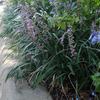
|
Lirope, Big BlueBotanical Name: Lirope muscari 'Big Blue'
[ More Info ]
|
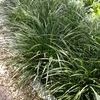
|
Lirope, GiantBotanical Name: Lirope muscari 'Emerald Goddess'
[ More Info ]
|

|
Lirope, GiantBotanical Name: Lirope muscari 'Super Big Blue'
[ More Info ]
|
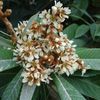
|
Loquat, Japanese PlumBotanical Name: Eriobotrya japonica
Native to China and Japan, the Japanese Plum loquat is an excellent medium sized tree that tolerates alkaline soils and drought, making it ideal for the Texas landscape. It makes an ideal specimen, accent, or privacy screen when several are grown in a row. Large thick leaves are up to twelve inches in length, dark green on top and light green on the bottom; new leaves are rust-colored and slightly pubescent. Fragrant clusters of yellow-white flowers appear in the early winter, which attract bees and butterflies easily. If grown in areas devoid of freezing temperatures, fruits develop and ripen in the spring. When ripe, they attract birds and wasp, so avoid planning right next to areas people sit or walk. [ More Info ]
|
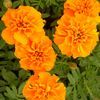
|
MarigoldBotanical Name: Tagetes erecta 'Janie'
Marigolds are popular annual flowers cherished for their bright, cheerful blooms and easy-to-grow nature. With their vibrant hues of yellow, orange, and red, marigolds add a splash of color to gardens, borders, and containers throughout the growing season. These resilient plants are known for their ability to thrive in various conditions, including full sun and poor soil, making them a favorite choice for beginner and experienced gardeners alike. Marigolds also possess natural pest-repellent properties, making them a valuable addition to vegetable gardens. With regular watering and deadheading, marigolds will continue to produce blooms abundantly, rewarding gardeners with their beauty from spring to fall. The Tagetes species are edible and have been utilized in various cuisines around the world for their distinct flavor and vibrant color. The petals of these edible marigolds can be used fresh or dried to add a subtle, tangy flavor and a pop of color to salads, soups, and other dishes. Additionally, marigold petals are sometimes used to infuse teas or garnish desserts, providing both aesthetic appeal and a unique taste.
[ More Info ]
|
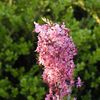
|
Mexican BuckeyeBotanical Name: Ungnadia speciosa
A Texas deciduous shrub that provides beautiful blooms and fall color. It is commonly found along the river and creek beds of central Texas, and grows well in poor soils and limestone areas, provided there is adequate drainage. Mexican Buckeye is generally multi-trunked, but can be pruned regularly to maintain a single trunk like a small tree. Clusters of bright pink flowers emerge before the leaves in the spring and are slightly fragrant. Before the blooms are spent, light bronze leaflets begin to emerge, turning light green. The pinnate leaves can be up to 12 inches long, with up to six pairs of leaflets, each up to five inches long. They turn a rich yellow color in the fall, falling at the first frost. New branches are smooth, however become fissured with age. Distinctive tri-valved seed pods develop through the summer, splitting open before fall to reveal the black seeds. It earned its name due to the seeds looking very similar to buckeyes, however, it is not related to Aesculus, and is the only species in the genus Ungadia. [ More Info ]
|

|
Miscellanous Item #1Botanical Name: Miscellanous Plant
Mortellaro's Nursery will at times have some miscellanous plants around the nursery to sell, and this page is simply a place holder for one of those plants. Assume these plants are of limited quantity, and will not be sold in the future. This page will NOT be updated with information about this plant, you will only see the name of the plant below if it is in stock, and what size, and what price (if you are logged in) [ More Info ]
|

|
Miscellanous Item #10Botanical Name: Miscellanous Plant
Mortellaro's Nursery will at times have some miscellanous plants around the nursery to sell, and this page is simply a place holder for one of those plants. Assume these plants are of limited quantity, and will not be sold in the future. This page will NOT be updated with information about this plant, you will only see the name of the plant below if it is in stock, and what size, and what price (if you are logged in) [ More Info ]
|

|
Miscellanous Item #11Botanical Name: Miscellanous Plant
Mortellaro's Nursery will at times have some miscellanous plants around the nursery to sell, and this page is simply a place holder for one of those plants. Assume these plants are of limited quantity, and will not be sold in the future. This page will NOT be updated with information about this plant, you will only see the name of the plant below if it is in stock, and what size, and what price (if you are logged in) [ More Info ]
|

|
Miscellanous Item #12Botanical Name: Miscellanous Plant
Mortellaro's Nursery will at times have some miscellanous plants around the nursery to sell, and this page is simply a place holder for one of those plants. Assume these plants are of limited quantity, and will not be sold in the future. This page will NOT be updated with information about this plant, you will only see the name of the plant below if it is in stock, and what size, and what price (if you are logged in) [ More Info ]
|

|
Miscellanous Item #13Botanical Name: Miscellanous Plant
Mortellaro's Nursery will at times have some miscellanous plants around the nursery to sell, and this page is simply a place holder for one of those plants. Assume these plants are of limited quantity, and will not be sold in the future. This page will NOT be updated with information about this plant, you will only see the name of the plant below if it is in stock, and what size, and what price (if you are logged in) [ More Info ]
|

|
Miscellanous Item #14Botanical Name: Miscellanous Plant
Mortellaro's Nursery will at times have some miscellanous plants around the nursery to sell, and this page is simply a place holder for one of those plants. Assume these plants are of limited quantity, and will not be sold in the future. This page will NOT be updated with information about this plant, you will only see the name of the plant below if it is in stock, and what size, and what price (if you are logged in) [ More Info ]
|

|
Miscellanous Item #15Botanical Name: Miscellanous Plant
Mortellaro's Nursery will at times have some miscellanous plants around the nursery to sell, and this page is simply a place holder for one of those plants. Assume these plants are of limited quantity, and will not be sold in the future. This page will NOT be updated with information about this plant, you will only see the name of the plant below if it is in stock, and what size, and what price (if you are logged in) [ More Info ]
|

|
Miscellanous Item #2Botanical Name: Miscellanous Plant
Mortellaro's Nursery will at times have some miscellanous plants around the nursery to sell, and this page is simply a place holder for one of those plants. Assume these plants are of limited quantity, and will not be sold in the future. This page will NOT be updated with information about this plant, you will only see the name of the plant below if it is in stock, and what size, and what price (if you are logged in) [ More Info ]
|

|
Miscellanous Item #3Botanical Name: Miscellanous Plant
Mortellaro's Nursery will at times have some miscellanous plants around the nursery to sell, and this page is simply a place holder for one of those plants. Assume these plants are of limited quantity, and will not be sold in the future. This page will NOT be updated with information about this plant, you will only see the name of the plant below if it is in stock, and what size, and what price (if you are logged in) [ More Info ]
|

|
Miscellanous Item #4Botanical Name: Miscellanous Plant
Mortellaro's Nursery will at times have some miscellanous plants around the nursery to sell, and this page is simply a place holder for one of those plants. Assume these plants are of limited quantity, and will not be sold in the future. This page will NOT be updated with information about this plant, you will only see the name of the plant below if it is in stock, and what size, and what price (if you are logged in) [ More Info ]
|

|
Miscellanous Item #5Botanical Name: Miscellanous Plant
Mortellaro's Nursery will at times have some miscellanous plants around the nursery to sell, and this page is simply a place holder for one of those plants. Assume these plants are of limited quantity, and will not be sold in the future. This page will NOT be updated with information about this plant, you will only see the name of the plant below if it is in stock, and what size, and what price (if you are logged in) [ More Info ]
|

|
Miscellanous Item #6Botanical Name: Miscellanous Plant
Mortellaro's Nursery will at times have some miscellanous plants around the nursery to sell, and this page is simply a place holder for one of those plants. Assume these plants are of limited quantity, and will not be sold in the future. This page will NOT be updated with information about this plant, you will only see the name of the plant below if it is in stock, and what size, and what price (if you are logged in) [ More Info ]
|

|
Miscellanous Item #7Botanical Name: Miscellanous Plant
Mortellaro's Nursery will at times have some miscellanous plants around the nursery to sell, and this page is simply a place holder for one of those plants. Assume these plants are of limited quantity, and will not be sold in the future. This page will NOT be updated with information about this plant, you will only see the name of the plant below if it is in stock, and what size, and what price (if you are logged in) [ More Info ]
|

|
Miscellanous Item #8Botanical Name: Miscellanous Plant
Mortellaro's Nursery will at times have some miscellanous plants around the nursery to sell, and this page is simply a place holder for one of those plants. Assume these plants are of limited quantity, and will not be sold in the future. This page will NOT be updated with information about this plant, you will only see the name of the plant below if it is in stock, and what size, and what price (if you are logged in) [ More Info ]
|

|
Miscellanous Item #9Botanical Name: Miscellanous Plant
Mortellaro's Nursery will at times have some miscellanous plants around the nursery to sell, and this page is simply a place holder for one of those plants. Assume these plants are of limited quantity, and will not be sold in the future. This page will NOT be updated with information about this plant, you will only see the name of the plant below if it is in stock, and what size, and what price (if you are logged in) [ More Info ]
|
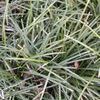
|
Monkey GrassBotanical Name: Ophiopogon japonicus
Popular evergreen clumping grass with foliage that only reaches twelve inches tall. Monkey Grass spreads by the roots, becoming an ideal groundcover for shady areas. Dwarf cultivar, 'Nana' reaches only 3 inches and spreads slowly. [ More Info ]
|

|
Monkey Grass, DwarfBotanical Name: Ophiopogon japonicus 'Nana'
Popular evergreen clumping grass with foliage that only reaches twelve inches in length. Monkey Grass spreads by the roots, becoming an ideal ground cover for shady areas.
Dwarf cultivar, 'Nana' reaches only 3 inches and spreads slowly.
[ More Info ]
|
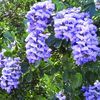
|
Mountain LaurelBotanical Name: Dermatophyllum secundiflorum
Extremely popular native found throughout the southern half of Texas. Naturally grows as a multi-trunked shrub or small tree with fragrant spring blooms. Texas Mountain Laurel is a slow growing evergreen that absolutely requires adequate drainage. Being native to rocky limestone areas, roots are not as robust and wide-growing as other trees, making container transplanting a cautious process. The dark green compound leaves can have up to 9 leaflets, and cast a reasonable shade underneath that allows some under planting. Naturally grows as a multi-trunked shrub, however can be trimmed into a small tree form. Very drought tolerant once established. Large pendulous clusters of violet-lavender blooms appear early in the spring, reaching up to 10 inches in length. The smell is notably that of grape-koolaid, and sadly they only last for two to three weeks. Legume seed pods contain bright red to orange seeds with a very resilient seed coat – it could take years for germination to naturally occur! The cotyledon (white part inside the seed) inside is highly toxic, however not easily digested if the seed coat is fresh. Mountain Laurel does fine without regular maintenance, however appreciates spring fertilization. [ More Info ]
|
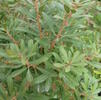
|
Myrtle, Southern WaxBotanical Name: Myrica cerifera
Native to the east Texas wetlands, Southern Wax Myrtle easily adapts to poorer soils, hot and dry conditions, and salty areas. It is a multi-trunked large shrub or small tree, spreading easily with an extensive underground root system. Naturally forms an open, irregular form, but responds well to pruning into a formed hedge or bonsai habit. Wax Myrtle is dioecious; males display small yellow-green catkins up to an inch long in the early spring, while in the late summer females have small inconspicuous flowers followed by small blue berries. The lime green leaves can be up to four inches long but only half an inch wide and are slightly aromatic when bruised. Small yellow glands are on the leaves, sometimes mistakened for a pest or disease. A dwarf cultivar, ‘Nana’, reaches only five feet high and wide. [ More Info ]
|
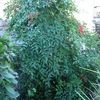
|
Nandina, CompactBotanical Name: Nandina domestica 'Compacta'
The bright green stems and branching habit of the Nandina earned it the name Heavenly Bamboo, however it does not belong in the same plant family. Native to China and Japan, Nandina is a semi-evergreen plant species with several cultivars that allow it to fill several roles in the landscape. ‘Compacta’ is a cultivar that only reaches 4 feet in height, making it more manageable in smaller landscapes. The distinctive compound leaves have several leaflets that grow out on non-branching stems. Nearly all species of Nandina spread outward with underground rhizomes that will give the Nandina clumping form over time. New foliage in the spring has a light red tint, turning green in the summer before turning red to red-bronze in the fall and winter. Large panicles of small white flowers appear on the ends of stems in the late spring, forming multitude of red-orange berries that provide handsome color in late summer and into winter. Birds seek the berries out for food in the winter, however they are mildly toxic to pets and livestock. All Nandina species are highly tolerant of poor soil condition and quality, as long as it’s given adequate drainage and not sand; when given at least mediocre care, it’s also highly pest and disease resistant. It is an ideal plant for rarely maintained landscapes. [ More Info ]
|
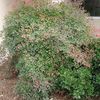
|
Nandina, DomesticBotanical Name: Nandina domestica
The bright green stems and branching habit of the Nandina earned it the name Heavenly Bamboo, however it does not belong in the same plant family. Native to China and Japan, Nandina is a semi-evergreen plant species with several cultivars that allow it to fill several roles in the landscape. The distinctive compound leaves have several leaflets that grow out on non-branching stems. Nearly all species of Nandina spread outward with underground rhizomes that will give the Nandina clumping form over time. New foliage in the spring has a light red tint, turning green in the summer before turning red to red-bronze in the fall and winter. Large panicles of small white flowers appear on the ends of stems in the late spring, forming multitude of red-orange berries that provide handsome color in late summer and into winter. Birds seek the berries out for food in the winter, however they are mildly toxic to pets and livestock. All Nandina species are highly tolerant of poor soil condition and quality, as long as it’s given adequate drainage and not sand; when given at least mediocre care, it’s also highly pest and disease resistant. It is an ideal plant for rarely maintained landscapes. [ More Info ]
|
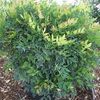
|
Nandina, GulfstreamBotanical Name: Nandina domestica 'Gulfstream'
The bright green stems and branching habit of the Nandina earned it the name Heavenly Bamboo, however it does not belong in the same plant family. Native to China and Japan, Nandina is a semi-evergreen plant species with several cultivars that allow it to fill several roles in the landscape. ‘Gulfstream’ is a cultivar from Hine’s Horticulture Inc. that is more compact and symmetrical in growth habit, making it the most manageable compact Nandina. The distinctive compound leaves have several leaflets that grow out on non-branching stems. ‘Gulfstream’ Nandina does not spread outward with underground rhizomes. New foliage in the spring has a flush of red color, turning blue-green in the summer before turning red-bronze in the fall and winter. ‘Gulfstream’ does not bloom heavily, and seldom sets berries. All Nandina species are highly tolerant of poor soil condition and quality, as long as it’s given adequate drainage and not sand; when given at least mediocre care, it’s also highly pest and disease resistant. It is an ideal plant for rarely maintained landscapes. [ More Info ]
|
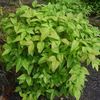
|
Nandina, NanaBotanical Name: Nandina domestica 'Nana Atropurpurea'
The bright green stems and branching habit of the Nandina earned it the name Heavenly Bamboo, however it does not belong in the same plant family. Native to China and Japan, Nandina is a semi-evergreen plant species with several cultivars that allow it to fill several roles in the landscape. ‘Nana’ is a very compact cultivar with a spherical growth habit. The distinctive compound leaves have several leaflets that grow out on non-branching stems. New foliage in the spring has a flush of bright green, turning bright yellow-green in the summer before turning crimson-red in the fall and winter. Rarely blooms and produces berries. All Nandina species are highly tolerant of poor soil condition and quality, as long as it’s given adequate drainage and not sand; when given at least mediocre care, it’s also highly pest and disease resistant. It is an ideal plant for rarely maintained landscapes. [ More Info ]
|
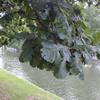
|
Oak, BurBotanical Name: Quercus macrocarpa
Bur Oak (also spelled Burr) is the most cold and drought tolerant of the oaks, able to thriveas far north as Alaska. A white oak, Bur Oak is a slow growing deciduous tree, averaging one foot per season. Naturally forms a wide open crown, growing wider than tall in the landscape, only starting to be taller than wide after reaching heights over 50 feet. The deeply ridged bar is ash-gray to dark brown in color, with fissures getting deeper with age. Leaves can grow up to nine inches in length, narrow but with deep lobes at the base, becoming much wider at the end. Bur Oak is monoecious, and blooms right after the leaves appear in the spring; yellow-green male catkins are up to four inches long, while female flowers are green and appear in short single spikes. The largest acorns of the oaks follow shortly thereafter – measuring up to two inches across. They are enclosed in a large cap with overlapping scales and sport an attractive fringe; it looks very much like the bur of a chestnut, giving this oak its name. Avoid planting Bur Oak in parking lots, as the acorns can damage vehicles. [ More Info ]
|
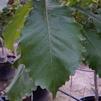
|
Oak, ChinquapinBotanical Name: Quercus muehlenbergii
Chinquapin (or chinkapin) oak is a white oak reaching heights of 70 feet while developing a natural round crown. Native to central Texas along the Guadalupe River, it tolerates limestone soils very well. The simple elliptical leaves have a sharp toothed pattern with no bristles, making it easily distinguishable amoungst other oaks. Yellowish catkin blooms cover the male trees in the spring, and can be a nuisance if planted near swimming pools. The acorns are some of the sweetest of all oaks, and can be eaten after being roasted. [ More Info ]
|
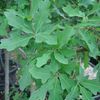
|
Oak, LaceyBotanical Name: Quercus laceyi
Native to central and south Texas, the Lacey Oak is known by many names – Quercus glaucoides, Blue Oak Canyon Oak, Encino Oak, Mountain Oak, Smokey Oak, or Rock Oak. It was previously awarded the title of a Texas Superstar for its wide tolerance of soil types (as long as well drained) and conditions and ease of transition into any Texas landscape. New foliage is slightly pubescent and peach colored, turning blue-green in the summer and brown to yellow in the fall. They are thicker to the touch than other oak leaves, and have shallow lobes. The tree exhibits an upright branching habit, and when grown in the wild can produce multiple trunks; nursery stock is often pruned for single trunk. Forms an irregular round crown, with shallow furrows and scaled ridged bark. Maturing at 35 feet, Lacey Oak is an ideal shade tree for the small backyard. [ More Info ]
|
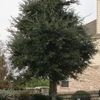
|
Oak, LiveBotanical Name: Quercus virginiana
Live Oak is not only a predominate icon of the Southern landscape, but a popular addition to many landscapes thanks to being fast growing, highly durable, and its longevity. It’s also resistant to salt spray, drought, and poor soil qualities. They are highly attractive found growing horizontally along the ground before reaching upward, however nearly all landscapers and homeowners choose a single, upright trunked specimen. Live Oak can also host other plants on its trunk and branches: ball moss, Spanish moss, mistletoe, and resurrection fern. Although Live Oak is evergreen, it will heavily defoliate in the late winter when new foliage begins to emerge. Leaves are stiff and leathery, shiny dark green on top and pale gray on the underside. Green catkin flowers up to four inches in length appear in the spring, dumping pollen that is easily spread by the wind. Acorns vary in size, averaging one inch in length and are tan-brown until turning black in the fall. The dark brown to black bark is thick and slightly furrowed, forming large alligator-scale bark plates as it ages. The wood is some of the heaviest of the oak family, commonly used for carpentry, fuel, and grilling. Sprouts from the roots can become a nuisance; dense saplings can surround the main trunk, requiring constant pruning if you wish to avoid a clump of trees. A fungus has also been identified as the culprit in oak wilt disease, killing many live oaks that have grown in the countryside throughout Texas. [ More Info ]
|
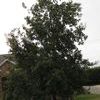
|
Oak, MexicanBotanical Name: Quercus polymorpha
Quercus polymorpha, commonly known as the Mexican Oak Tree, is a remarkable white oak species native to Mexico. Considered an evergreen tree, the Mexican Oak has glossy dark green leaves that persist throughout the year. However in the spring, undergoes a unique shedding of nearly half its leave and puts out new ones. Standing tall at heights of up to 80 feet, the Mexican Oak has naturalized itself well in Texas. Its leaves are typically characterized by rounded lobes, typical of white oak species, and it produces acorns that mature in a single year. These acorns are an essential food source for various wildlife species, contributing to the rich biodiversity of the region. Mexican oak is a popular choice for the Texas landscape due to its remarkable adaptability to a variety of soils and weather conditions. Being a white oak, it’s also more resistant to Oak Wilt disease. [ More Info ]
|
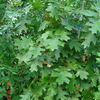
|
Oak, RedBotanical Name: Quercus shumardii
Texas native Shumard Oak is commonly found along creeks and swamps where it prefers moist well-drained soils. Reaching heights over 100 feet and up to 60 feet in width, forming a broad pyramidal crown; it is one of the largest red oaks available, so plant with consideration. New growth is light grey and very smooth. With age, the trunk and branches begin to darken, developing ridges and becoming only slightly furrowed. The broad leaves are lobbed with distinctive points, growing up to eight inches in length. They are dark green on top, light green on the bottom, and turn shades of yellow, red and brown in the fall. Under late summer heat stress or drought conditions, leaves will die and fall premature. Acorns are up to one inch in diameter, but take up to three years to fully mature; they are common food source for birds, squirrels, and deer. [ More Info ]
|
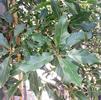
|
Oak, SierraBotanical Name: Quercus canbyi
Sierra Oak, a red oak, naturally grows in a pyramidal shape while it is young, developing a broader canopy after several years. With a mature size of 30 feet tall, it is an idea oak tree for the medium sized Texas landscape, and can grow in any area throughout Texas. Although it's classified as an evergreen, it will shed a majority of its leaves in the late winter much like Live or Mexican Oak. New foliage is red before turning a rich green color, turning red again in the fall. Laves are up to three inches long, and resemble a holly leaf. [ More Info ]
|
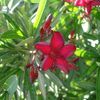
|
Oleander, DwarfBotanical Name: Nerium oleander 'cv.'
Oleander is a popular evergreen blooming landscape shrub that presumably originated from Asia; in the genus Nerium, it is the only species with over 400 cultivars accounted for. A popular choice due to its rapid growth habit, marvelous blooms, and tolerance to drought and poor soils. Oleander sends out large erect stems outward from its base in every direction. The leaves are arranged in whorls around the branches, bright to dark green, thick and leathery reaching up to six inches in length. The dwarf cultivars leaves are slightly smaller, and overall the plant matures at five feet. Every spring, clusters of flowers up to one and a half inches in diameter emerge on the tips of new branches, persisting for several weeks, and then continue to emerge sporadically throughout the season. The fruits that follow are long narrow capsules that contain numerous seeds. Oleander is one of the most poisonous landscape plants available – every part of the plant is toxic. Lately, it has had serious issues with bacterial blight, which is easily cultivated in areas without good air circulation or high moisture. The first stages result in black and brown spots on the leaves, followed by total defoliation of stems. Once canker growths are forming on the stems, it’s too late to try and save. The bacteria will remain in the soil, so any new oleanders that are planted there will surely get the disease again. [ More Info ]
|
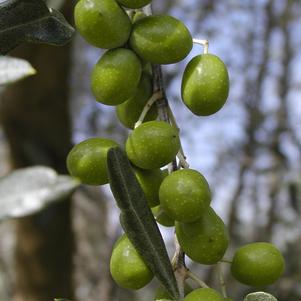
|
Olive, ArbequinaBotanical Name: Olea europaea 'Arberquina'
Native to the Mediterranean, Olive trees have quickly found their place in the Texas landscape. They are utilized for their hardiness with the weather, tolerance to poor soils, and manageable size. Some of the olive trees overseas are known to be over 1,000 years old. The Olive tree often has multiple trunks, however often trained to have a single trunk; if it severely damaged or cut down, new trunks will emerge from the roots. The grey-green leaves are thick and leathery, with stomata on the undersides that aid in water conservation. Flower buds are borne on the axils of leaves, often budding up a year before they open. The inflorescences average 15 to 30 flowers, but are often inconspicuous, but with a slight fragrance. The drupe olive fruits start green, and turn black when they ripen in the fall. It is commonly believed they are toxic, however they are simply extremely bitter and often get cured before being eaten. 'Arberquina' is from Spain. [ More Info ]
|
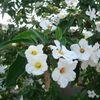
|
Olive, MexicanBotanical Name: Cordia boissieri
The Mexican Olive is native to southern areas of Texas, but will not grow north of Austin due to its low tolerance to freezing temperatures. A large shrub that is easily pruned into small tree form, it averages twenty feet high, making it ideal for small landscape areas. It is also drought tolerance once established, and tolerates any quality of soil as long as it’s adequately drained. Soft, dark-green leaves are a wonderfull backdrop to the clusters of showy white trumpet-shaped flowers that appear throughout the spring and summer. The fleshy fruits that follow feed the birds, deer, and cattle that find them, but they are slightly toxic and not for us to eat. Pest and disease free, Texas Olive’s only real issue is tenderness to freeze damage; it can recover from a light freeze, but only waiting till the growth comes back in the summer will you be able to tell if it didn’t make it. [ More Info ]
|
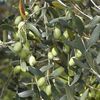
|
Olive, MissionBotanical Name: Olea europaea 'Mission'
Native to the Mediterranean, Olive trees have quickly found their place in the Texas landscape. They are utilized for their hardiness with the weather, tolerance to poor soils, and manageable size. Some of the olive trees overseas are known to be over 1,000 years old. The Olive tree often has multiple trunks, however often trained to have a single trunk; if it severely damaged or cut down, new trunks will emerge from the roots. The grey-green leaves are thick and leathery, with stomata on the undersides that aid in water conservation. Flower buds are borne on the axils of leaves, often budding up a year before they open. The inflorescences average 15 to 30 flowers, but are often inconspicuous, but with a slight fragrance. The drupe olive fruits start green, and turn black when they ripen in the fall. It is commonly believed they are toxic, however they are simply extremely bitter and often get cured before being eaten. [ More Info ]
|

|
Olive, Mission (Standard Form)Botanical Name: Olea europaea 'Mission'
Native to the Mediterranean, Olive trees have quickly found their place in the Texas landscape. They are utilized for their hardiness with the weather, tolerance to poor soils, and manageable size. Some of the olive trees overseas are known to be over 1,000 years old. The Olive tree often has multiple trunks, however often trained to have a single trunk; if it severely damaged or cut down, new trunks will emerge from the roots. The grey-green leaves are thick and leathery, with stomata on the undersides that aid in water conservation. Flower buds are borne on the axils of leaves, often budding up a year before they open. The inflorescences average 15 to 30 flowers, but are often inconspicuous, but with a slight fragrance. The drupe olive fruits start green, and turn black when they ripen in the fall. It is commonly believed they are toxic, however they are simply extremely bitter and often get cured before being eaten. [ More Info ]
|
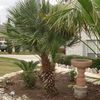
|
Palm, Mediterrarean FanBotanical Name: Chamaerops humilis
The Mediterranean Fan palm, or European Fan Palm, is a cold-hardy palm that keeps a maintainable size at 20 feet tall and 15 feet wide. The main trunk is often covered in brown bristly-hairs, with the base of old leaves persisting. The blue-green leaves predominantly have an upright habit, and can reach up to two feet across --the stems are lined with extremely stiff spines. Although small and of manageable size, the Mediterranean Fan Palm often sprouts multiple trunks from the base, resulting in a clump-forming palm as it matures. Although some home owners desire to have a single trunk, it’s not easy as the small trunks are secure at the base, and the leaves are covered in those vicious spines. Bright yellow flowers appear at the top of the trunk, but are often hidden behind the leaves and often go unnoticed. The reddish-brown fruits that follow are often unseen as well. Grows very well with regular watering, however will tolerate drought conditions and poor soils as long as it’s given adequate drainage. [ More Info ]
|
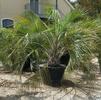
|
Palm, PindoBotanical Name: Butia capitata
This feather leaf palm is best planted in large areas where the leaves don’t need to be trimmed to make room for walkways or traffic. The overall height of the Pindo is only 20 feet, however the leaves can reach up to 10 feet past the four foot stems, falling downward then curving back towards the trunk. They are pinnate, and blue-gray to silver-gray in color, with spines down the leaf stems. In the late spring to early summer female palms have a thick pink-purple inflorescence emerging from the crown. Fall brings bright orange pindo dates that are popular for making jellies and jams. If left on the plant, they can create a large mess that attracts insects and vermin. Pindo Palm doesn’t tolerate extended periods of freezing temperatures, and grows best in well-drained sandy soils. Once established, it’s incredibly drought tolerant. [ More Info ]
|
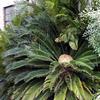
|
Palm, SagoBotanical Name: Cycas revoluta
This landscape palm is a lovely conversation piece for any landscape, as it can fire up debates depending on your beliefs -- scientist estimate this plant was growing on this planet over 150 million years ago! Sago Palm is almost a misnomer, as it belongs to the plant family Cycadaceae, and is a palm only by aesthetics alone. It forms a prominent trunk that grows very slow with age. Once or possibly twice a year, new bright green leaves emerge from the central trunk, then slowly unfurling like a fern to reveal leaves up to five feet long. Although soft to the touch and fragile, the leaves eventually harden up with a stiff midrib, sporting plenty of needle like leaves with a sharp point, turning dark green. Leaves are noticeably larger when grown in full shade. Sago Palm is dioecious, with easily identified blooms for the male and female. It also reproduces from small suckers borne at the base of the plant; the ideal time to remove them would be in winter with a shovel or hatchet. Sago palm appreciates well drained soils, and a slow release fertilizer on a regular basis . Be sure to cover in freezing temperatures as leaves will die if exposed too long, and it would take quite a while to replenish all the leaves. [ More Info ]
|
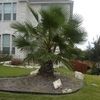
|
Palm, WashintoniaBotanical Name: Washingtonia filifera
An attractive upright growing palm that sways easily in the wind as the gray-ringed trunk is at maximum twelve inches thick; this palm sways easily in the wind. Greatly appreciates rich, fertile soils but can tolerate worse and even withstand periods of drought. The large palmate leaves have a slight drooping effect on the ends, and grow up to five feet in length and width. The leaf steams are light green with orange streaks, and have prominent spines along both edges. Once the older leaves die, they lay down flat and begin to form a highly attractive skirt or curtain around the trunk. Several years’ worth of leaves will continue to fall and pile on each other, which although attractive, can become the home of rats and other vermin -- great care must be taken when pruning old dead leaves. Creamy white inflorescences appear in the early summer on stalks up to ten feet in length, growing out beyond the leaves. They produce black berries that easily attract wildlife, or germinate quickly after falling to the ground. [ More Info ]
|
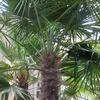
|
Palm, WindmillBotanical Name: Trachycarpus fortunei
Windmill Palm is the most cold-hardy upright palm available for the state of Texas. Relatively fast growing if grown in fertile soil with regular watering, but can grow in drought conditions with little soil nutrients. Windmill is idea in tight landscape areas as it’s completely upright growing, with the main trunk no more than twelve inches in diameter. The large palm leaves are at the end of stems up to three feet in length, forming a nearly completely symmetrical crown. To assist in identification, there are no thorns on the palm branches. The upper trunk is covered in a loose mat of brown fiber, while lower trunk is uncovered, displaying a handsome smooth ringed trunk. Windmill is dioecious, meaning only the female will bear large long branched inflorescence blooms in the spring, with clusters of blue fruits in the fall. [ More Info ]
|
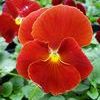
|
PansyBotanical Name: Viola x
Popular bedding plants that bloom all winter long. Mainly come in a blue-yellow-white flower, but also available in yellows, creams, and blues. Self-seeds easily. 2009 Expected Cultivars: Colossus Deep Blue W/ Blotch [ More Info ]
|
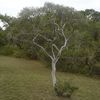
|
Persimmon, TexasBotanical Name: Diospyros texana
Outstanding Texas native found in the rocky limestone areas from west to east texas; Texas Persimmon is a small tree with an irregular growth habit, known for its tolerance to pretty much most of Texas in terms of environment, weather, and pest. The trunk has smooth, light gray bark; as it matures, it peels off in slightly brittle patches displaying fresh bark with shades of white, grey, and pink. Leaves are only up to two inches in length, light to dark green and slightly rolled downward on the sides. Flowers are borne only on female Persimmon trees, never more than a half-inch wide and bell shaped. They appear in clusters on new growth in March to April, then form small one inch wide green fruits that turn black and ripen in September. Although they are edible, they do well in attracting wildlife; they also stain clothes and desk easily so avoid planting in foot paths. [ More Info ]
|

|
PetuniaBotanical Name: Petunia hybrida
The Petunia 'Dreams Series' stands as a captivating choice for landscape designers and gardeners seeking vibrant, long-lasting blooms. This series offers a diverse palette of colors, including shades of pink, purple, blue, and white, creating a dreamy tapestry of hues. With its mounding growth habit and abundant blossoms, 'Dreams Series' petunias add a burst of color to garden beds, borders, hanging baskets, and containers. These versatile annuals thrive in sunny locations with well-drained soil, exhibiting excellent heat tolerance and continuous flowering throughout the growing season. Whether used as a focal point or as part of a mixed planting scheme, Petunia 'Dreams Series' lends an enchanting allure to any landscape, making it a beloved choice for both beginner and seasoned gardeners alike.
Spring 2024
[ More Info ]
|
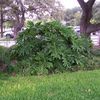
|
Philodendron, Split LeafBotanical Name: Philodendron selloum
This tropical Brazilian native is semi-hardy for southern Texas; with large glossy leaves growing off a large unbranching stem that sprawls along the ground. The leaves are up to three feet in length, dissected into many large lobes with slight ruffles. It will reach heights of ten feet in warm climates, or dies back in colder only to return if protected sufficiently. The bloom isn’t really noticeable; it emerges from the base only one foot in height, a modified leaf with a hood, with a club-shaped base in the middle being the flower. Philodendron appreciates moist, well drained soils and does not tolerate drought conditions at all. It should be placed in the landscape with consideration of the directly the stem can grow. [ More Info ]
|
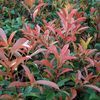
|
Photinia x fraseriBotanical Name: Photinia x fraseri
Red Tip Photinia is a popular, fast growing, evergreen shrub commonly used as a screen or large hedge, reaching 15 feet tall and wide. Fraseri has some tolerance to leaf spot and mildew, and is best grown in well ventilated sunny areas. Large white blooms in the spring are only one of the visual aesthetics; rich bronze-red new foliage emerges from the branch tips, giving the Photinia the nickname "Redtip Photinia". They eventually turn a handsome green a month later, but new foliage will continue to slowly emerge through the summer. Easily pruned into hedges, topiaries, or even tree forms. Photinia is drought tolerant once established, but it is in no way deer tolerate – it ranks pretty high on the deer’s favorite menu item right after Hawthorns. [ More Info ]
|
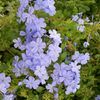
|
PlumbagoBotanical Name: Plumbago auriculata
Perennial best known for its large clusters of blue flowers spring to fall. Easily spreads up to five feet wide while reaching three feet tall.
[ More Info ]
|
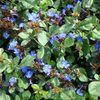
|
Plumbago, DwarfBotanical Name: Ceratostigma plumbaginoides
This dwarf species looks almost nothing like regular Plumbago. The dark green leaves contrast the deep blue flowers that do not form large balls of flowers, but are loosly borne with only a few others at the ends of branches.
Low growing perennial reaching only 15 inches high and wide, however spreads by underground rhizomes to become an attractive groundcover. Only slighly invasive with no serious pest or disease problems.
Will die easily in poorly drained soils or from over-watering, and grows best with full sun in the morning and part shade in the heat of the afternoon.
[ More Info ]
|
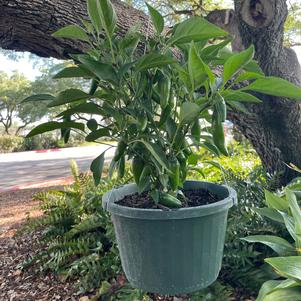
|
Pot-a-peno Jalapeno PepperBotanical Name: Capsicum annuum
Unique Jalapeno plant, as the cascading growth habit makes it ideal for a hanging basket or tall container. Early maturing, being one of the first peppers of the season. [ More Info ]
|
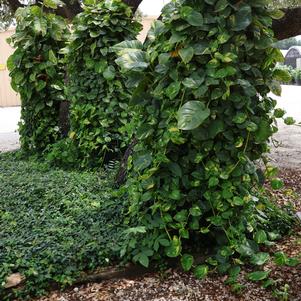
|
Pothos IvyBotanical Name: Epipremnum aureum
[ More Info ]
|
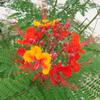
|
Pride of BarbadosBotanical Name: Caesalpinia pulcherrima
Known also as the Peacock Tree or Mexican Bird of Paradise, Pride of Barbados is native to the West Indies. An annual in north Texas, perennial in central to south, it reaches average heights of six feel tall in a growing season. It has a very open, spreading habit, multiple branches with small thorns so avoid planting directly on walking paths. The bright green bipinnately compound leaves are very light, almost fern-link with leaflets no longer than three-quarters of an inch. It turns reddish yellow in the fall before dropping. Starting in the spring, large panicles of bright red, orange, and yellow blooms with long red stamens appear on the terminal ends of the branches. They continue to appear till fall, and are followed by seed pods no more than three inches long that dry over winter and split open, releasing the seeds. Pride of Barbados requires easily drained soils, and can grow in acidic or alkaline areas. Mulch heavily to ensure protection from death in colder areas. Prune dead branches, or bring down to a manageable size in the late winter. [ More Info ]
|
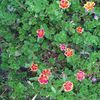
|
PurslaneBotanical Name: Portulaca oleracea
[ More Info ]
|
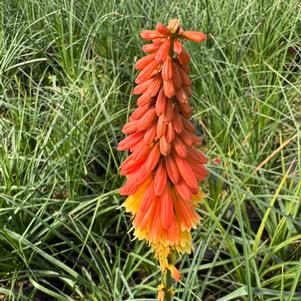
|
Red Hot PokerBotanical Name: Kniphofia uvaria 'Flamenco Mix'
Kniphofia uvaria, also known as Red Hot Poker, is a striking and popular plant known for its bright, torch-like flower spikes that bloom from mid-summer to fall. The plant is also commonly referred to as red hot poker or torch lily due to its long, narrow, brightly colored flowers that resemble the shape of a flaming torch. The 'Flamenco Mix' variety of Kniphofia uvaria is a modern cultivar that was developed to have vivid flower spike plumes of yellow mixed with orange and fiery red. This plant features slender, grass-like foliage that forms a clump up to 2 feet tall and wide. The foliage is a vibrant green and is evergreen in mild climates. The flower spikes of Kniphofia uvaria 'Glowstick' grow up to 30 inches tall and are a bright yellow-green color, gradually turning to a vibrant coral-orange as they mature. The flowers are arranged in a dense cluster and are attractive to bees, butterflies, and hummingbirds. Kniphofia uvaria 'Glowstick' is a low-maintenance plant that thrives in full sun to partial shade and well-draining soil. It is drought-tolerant and can adapt to a wide range of soil types. This plant is ideal for mixed borders, rock gardens, and as a specimen plant in containers. [ More Info ]
|
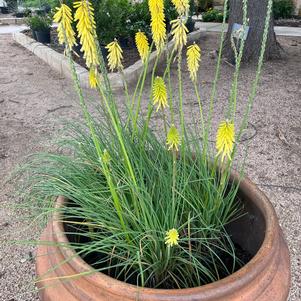
|
Red Hot Poker (Yellow)Botanical Name: Kniphofia uvaria 'Glowstick'
Kniphofia uvaria 'Glowstick' is a striking and popular plant known for its bright, torch-like flower spikes that bloom from mid-summer to fall. The plant is also commonly referred to as red hot poker or torch lily due to its long, narrow, brightly colored flowers that resemble the shape of a flaming torch. The 'Glowstick' variety of Kniphofia uvaria is a modern cultivar that was developed to have brighter and longer-lasting flowers than the traditional species. This plant features slender, grass-like foliage that forms a clump up to 2 feet tall and wide. The foliage is a vibrant green and is evergreen in mild climates. The flower spikes of Kniphofia uvaria 'Glowstick' grow up to 30 inches tall and are a bright yellow-green color, gradually turning to a vibrant coral-orange as they mature. The flowers are arranged in a dense cluster and are attractive to bees, butterflies, and hummingbirds. Kniphofia uvaria 'Glowstick' is a low-maintenance plant that thrives in full sun to partial shade and well-draining soil. It is drought-tolerant and can adapt to a wide range of soil types. This plant is ideal for mixed borders, rock gardens, and as a specimen plant in containers. [ More Info ]
|
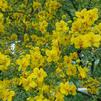
|
Retama TreeBotanical Name: Parkinsonia aculeata
A fast growing Texas native tree with beautiful long arching, somewhat drooping, branches with thorns at the nodes. Cast a very light shade due to the very small leaves along the stems. Complimented nicely with multitude of bright yellow flowers borne in the spring and continue into the fall. Seed pods up to six inches in length follow, and persist on the tree until next spring when they begin to fall to the ground. Retama tree is highly drought tolerant once established, and has no serious pest or disease issues. [ More Info ]
|
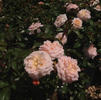
|
Rose, Apricot Drift ®Botanical Name: Rosa x 'Meimirrote'
[ More Info ]
|
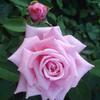
|
Rose, Belinda's DreamBotanical Name: Rosa chinensis 'Belinda's Dream'
Originally introduced in 1988, Belinda’s Dream is a cross between ‘Tiffany’ and ‘Jersey Beauty’. It is the first rose to receive both a Texas Superstar and Earthkind designation. It’s quite resistant to black spot, mildew, and rust when planted in full sun and highly ventilated areas. The dark blue-green foliage is a handsome backdrop for the large heavy double blooms that emerge on new branches, and have a slight fragrance. They are often borne on long branches, making them ideal for cut arrangements. The shrub maintains an upright growth habit, and is quite sturdy up to five feet in height. Prune heavily in the late winter before spring to encourage heavy bloom set. [ More Info ]
|
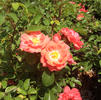
|
Rose, Coral Drift®Botanical Name: Rosa x 'Meidrifora'
Coral Drift Roses are a patented rose from Conard-Pyle, and information on them can be found here : http://www.conard-pyle.com/index.cfm/fuseaction/drplants.plantDetail/plant_id/599/index.htm [ More Info ]
|
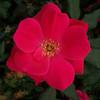
|
Rose, Knock Out®Botanical Name: Rosa chinensis 'Radrazz'
Originally developed by William Radler, Conard Pyle holds the patent on one of the most popular line of roses that have reinvigorated roses for the Texas landscapes – the Knock Out Roses. The original of several cultivars, ‘Radrazz’ Knock Out Rose is highly resistant to diseases that plague other roses, while being very tolerant of hot and dry climates familiar to Texas. Since introduction, it has become the fastest selling new rose of all time. The single blooms are a deep red cherry color, and appear abundantly in the late winter for a week or two, then drop off only to continue blooming again throughout the summer until first real frost. To maximize the amount of blooms, trimming the shrub midwinter will encourage more branches to fill out the plant, thus more blooms. The foliage is a dark purple hue as it emerges, turning dark green for the summer. In the fall it turns a dark burgundy. Won the All-America Rose award in 2000 when introduced, and Texas Superstar in 2004; Knockout has become a commonplace addition to any landscape since. [ More Info ]
|
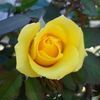
|
Rose, NacogdochesBotanical Name: Rosa chinensis 'Nacogdoches'
Alternatively known as "Grandma's Yellow", Nacogdoches Rose is the 2009 "Yellow Rose of Texas", a Texas Superstar. Nacogdoches Rose is a spectacular landscape addition, due to the blooming period starting in late winter and continuing till the next freeze. Wild temperature fluctuations will cause it to stop blooming, but only for a short time. The flowers are a rich shade of yellow, and can have up to 25 petals. They stand out nicely against the dark green leaves. Provide adequate drainage, and Nacogdoches Rose can grow in acidic or alkaline soils. [ More Info ]
|
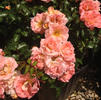
|
Rose, Peach Drift®Botanical Name: Rosa x 'Meiggili'
Peach Drift Roses are a patented rose from Conard-Pyle, and information on them can be found here : http://www.conard-pyle.com/index.cfm/fuseaction/drplants.plantDetail/plant_id/596/index.htm [ More Info ]
|
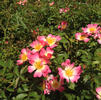
|
Rose, Pink Drift®Botanical Name: Rosa x 'Meijocos'
Pink Drift Roses are a patented rose from Conard-Pyle, and information on them can be found here : http://www.conard-pyle.com/index.cfm/fuseaction/drplants.plantDetail/plant_id/597/index.htm [ More Info ]
|
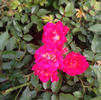
|
Rose, Red Drift®Botanical Name: Rosa x 'Meigalpio'
Red Drift Roses are a patented rose from Conard-Pyle, and information on them can be found here : http://www.conard-pyle.com/index.cfm/fuseaction/drplants.plantDetail/plant_id/598/index.htm [ More Info ]
|
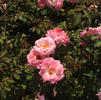
|
Rose, Sweet Drift®Botanical Name: Rosa x 'Meiswetdom'
Sweet Drift Roses are a patented rose from Conard-Pyle, and information on them can be found here : http://www.conard-pyle.com/index.cfm/fuseaction/drplants.plantDetail/plant_id/968/index.htm [ More Info ]
|
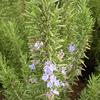
|
RosemaryBotanical Name: Rosmarinus officinalis 'Gorizia'
Mediterranean native that is no stranger to hot and dry conditions, on top of rocky soils. The highly aromatic needle-like leaves are complimented in the late winter with small blue flowers, no more than one inch in diameter and somewhat tubular. Rosemary requires well-drained alkaline soils, otherwise will be easily prone to disease and dieback when overwatered. No matter the location in the landscape, full sun must be provided. The foliage is commonly used in cooking, aroma therapy, and for medicinal purposes. This cultivar, 'Gorizia' has thicker woody stems that make it ideal to strip leaves and put the food to BBQ right on the stem.
[ More Info ]
|
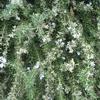
|
Rosemary, WeepingBotanical Name: Rosmarinus officinalis 'Prostratus'
A Mediterranean native that is no stranger to hot and dry conditions on top of rocky soils. The highly aromatic needle-like leaves are complimented in the late winter with small blue flowers, no more than one inch in diameter and somewhat tubular. The weeping rosemary is an excellent choice for raised beds, where the leaves can drape over and cover the wall. Rosemary requires well-drained alkaline soils, otherwise will be easily prone to disease and dieback when overwatered. No matter the location in the landscape, full sun must be provided. The foliage is commonly used in cooking, aroma therapy, and for medicinal purposes. [ More Info ]
|
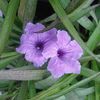
|
Ruellia, Katie Mexican PetuniaBotanical Name: Ruellia x brittoniana 'Katie'
Dwarf cultivar of Ruellia that grows very quickly, spreading quickly through reseeding. Delicate looking trumpet flowers are a blue-purple hue, and at the top of the plant borne in clusters up to three. They start to appear in late spring, and continue till fall. Highly drought and heat tolerant, and can become invasive if used in small areas.
[ More Info ]
|
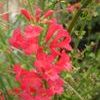
|
Russelia, RedBotanical Name: Russelia sp.
Native to Mexico, this fast growing small shrub has long slender branches that grow up to four feet tall, then easily cascade over making it ideal for raised flowerbeds. The wirey leaves on the branches are mixed in with clusters of flowers that first appear in the spring and persist till fall. The blooms are one inch in length, red-scarlet and narrow till the end where they open up - resembling small fire crackers. Firecracker plant appreciates regular watering and fertilizer, however can continue to bloom through the dry summer. Easily attracts hummingbirds and butterflies.
[ More Info ]
|
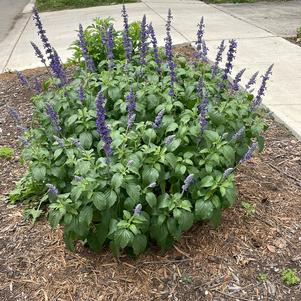
|
Salvia Mystic SpiresBotanical Name: Salvia longispicata x farinacea 'Mystic Spires'
[ More Info ]
|
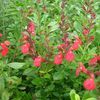
|
Salvia, Greggii CoralBotanical Name: Salvia greggii
Texas native, Autumn Sage is a popular semi-evergreen shrub ideal for hot and dry and well-drained alkaline soils. Once established, it is one of the best drought tolerant choices for any landscape. Branch growth normally originates from the base, forming a natural vase shape with dull green aromatic leaves. Blooms appear in abundance spring to fall, attracting hummingbirds and butterflies with ease. Appreciates a good pruning in the winter when leaves have fallen off. [ More Info ]
|
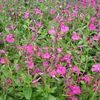
|
Salvia, Greggii PinkBotanical Name: Salvia greggii
Texas native, Autumn Sage is a popular semi-evergreen shrub ideal for hot and dry and well-drained alkaline soils. Once established, it is one of the best drought tolerant choices for any landscape. Branch growth normally originates from the base, forming a natural vase shape with dull green aromatic leaves. Blooms appear in abundance spring to fall, attracting hummingbirds and butterflies with ease. Appreciates a good pruning in the winter when leaves have fallen off. [ More Info ]
|
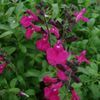
|
Salvia, Greggii RaspberryBotanical Name: Salvia greggii
Texas native, Autumn Sage is a popular semi-evergreen shrub ideal for hot and dry and well-drained alkaline soils. Once established, it is one of the best drought tolerant choices for any landscape. Branch growth normally originates from the base, forming a natural vase shape with dull green aromatic leaves. Blooms appear in abundance spring to fall, attracting hummingbirds and butterflies with ease. Appreciates a good pruning in the winter when leaves have fallen off. [ More Info ]
|
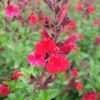
|
Salvia, Greggii RedBotanical Name: Salvia greggii
Texas native, Autumn Sage is a popular semi-evergreen shrub ideal for hot and dry and well-drained alkaline soils. Once established, it is one of the best drought tolerant choices for any landscape. Branch growth normally originates from the base, forming a natural vase shape with dull green aromatic leaves. Blooms appear in abundance spring to fall, attracting hummingbirds and butterflies with ease. Appreciates a good pruning in the winter when leaves have fallen off. [ More Info ]
|
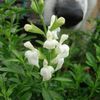
|
Salvia, Greggii WhiteBotanical Name: Salvia greggii
Texas native, Autumn Sage is a popular semi-evergreen shrub ideal for hot and dry and well-drained alkaline soils. Once established, it is one of the best drought tolerant choices for any landscape. Branch growth normally originates from the base, forming a natural vase shape with dull green aromatic leaves. Blooms appear in abundance spring to fall, attracting hummingbirds and butterflies with ease. Appreciates a good pruning in the winter when leaves have fallen off. [ More Info ]
|
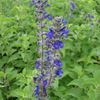
|
Salvia, Indigo SpiresBotanical Name: Salvia x 'Indigo Spires'
Hybrid between S. farinaea and S. guaranitica. Vigorous perennial recognized for the long twisting flower spikes that appear non stop throughout the warm season. Appreciates full sun and adequate drainage, and recovers quickly from pruning if you chose to control it’s size. Easily attracts butterflies and humming birds. [ More Info ]
|
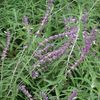
|
Salvia, leucanthaBotanical Name: Salvia leucantha
Tough, low maintenance perennial with stunning purple & white blooms throughout the summer months. Grows four feet tall and wide.
[ More Info ]
|

|
Salvia, lyrataBotanical Name: Salvia lyrata
More Info Soon [ More Info ]
|
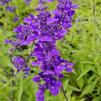
|
Salvia, Mealy Blue SageBotanical Name: Salvia farinacea 'Evolution'
Summer blooming perennial that grows three feet tall and two feet wide. Color is predominately purple....although a color blind person may see blue. [ More Info ]
|
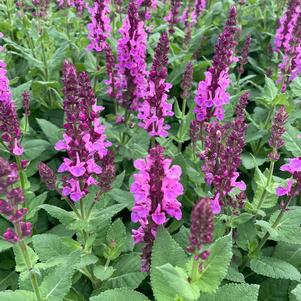
|
Salvia, Rose MarvelBotanical Name: Salvia nemorosa 'Marvel Rose'
Salvia nemorosa, also known as woodland sage, is a perennial herb originating from Europe and Western Asia. The cultivar ‘Marvel Rose’ has some of the largest flowers of any salvia nemorosa. Its graceful stature, reaching around 14 to 16 inches, is adorned with lance-shaped, gray-green leaves emitting a delightful fragrance when crushed. The rose-pink flowers appear spring to fall. Not only admired for its aesthetic appeal, Salvia nemorosa also attracts pollinators like bees and butterflies, enhancing its ecological significance. Thriving in well-drained soil and full sunlight, this salvia is a hardy and drought-tolerant perennial, making it a popular choice for various garden settings, including borders and rock gardens. Regular pruning after flowering helps maintain its shape and encourages additional blooms. [ More Info ]
|
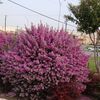
|
Senisa, CompactBotanical Name: Leucophyllum frutescens 'Compacta'
Senisa, or Cenizo, is a Texas native shrub that tolerates just about any type or condition of soil as long as excellent drainage is provided; tolerates heat, drought, and salt spray very well. The semi-loose round growth habit can be amended with regular pruning, encouraging a tighter and more uniform growth habit. The silver foliage is moderately pubescent, no more than one inch in length. Purple-pink tubular flowers appear throughout the growing season, primarily after a healthy rain. Senisa is a superior choice for xeriscaping, but can fit easily into any greenscape. No serious pest or disease issues. [ More Info ]
|
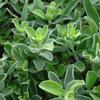
|
Senisa, GreencloudBotanical Name: Leucophyllum frutescens 'Greencloud'
Senisa, or Cenizo, is a Texas native shrub that tolerates just about any type or condition of soil as long as excellent drainage is provided; tolerates heat, drought, and salt spray very well. The semi-loose round growth habit can be amended with regular pruning, encouraging a tighter and more uniform growth habit. The foliage is moderately pubescent, no more than one inch in length. Purple-pink tubular flowers appear throughout the growing season, primarily after a healthy rain. 'Greencloud' has a slightly faster growth habit over Compact Senisa, and the foliage is grayish-green. Senisa is a superior choice for xeriscaping, but can fit easily into any greenscape. No notable pest or disease issues. [ More Info ]
|
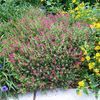
|
SkullcapBotanical Name: Scutellaria suffrutescens
Semi-deciduous perennial that blooms spring to fall, establishing a small twelve inch tall and two foot wide ball. Good drainage is a must.
[ More Info ]
|
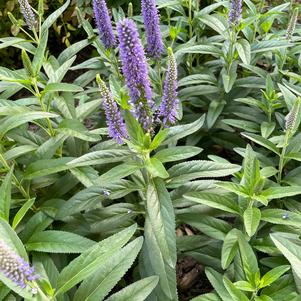
|
Skyward Blue VeronicaBotanical Name: Veronica longifolia 'Skyward Blue'
Veronica longifolia Skyward™ Blue is a beautiful cultivar of the Veronica plant that is prized for its striking blue flowers that bloom on tall, sturdy stems. This perennial plant typically grows to a height of 2 to 3 feet and has a spread of about 1 to 2 feet. The foliage is a rich green color and is lance-shaped with a serrated edge. This plant is very easy to grow and maintain, making it a popular choice for gardeners of all skill levels. It prefers full sun to partial shade and well-drained soil. It is drought-tolerant and can thrive in a variety of soil types. Veronica longifolia Skyward™ Blue is also resistant to most pests and diseases. One of the best features of this plant is its abundant flowering. The blue flowers bloom from late spring to early fall and are a favorite of pollinators such as bees and butterflies. The flowers are long-lasting and can be used for cut arrangements or left on the plant to enjoy in the garden. Overall, Veronica longifolia Skyward™ Blue is an excellent choice for anyone looking to add some vibrant color to their garden. [ More Info ]
|

|
Skyward Pink VeronicaBotanical Name: Veronica longifolia 'Skyward Pink'
Veronica longifolia Skyward™ Pink is a beautiful cultivar of the Veronica plant that is prized for its striking pink flowers that bloom on tall, sturdy stems. This perennial plant typically grows to a height of 2 to 3 feet and has a spread of about 1 to 2 feet. The foliage is a rich green color and is lance-shaped with a serrated edge. This plant is very easy to grow and maintain, making it a popular choice for gardeners of all skill levels. It prefers full sun to partial shade and well-drained soil. It is drought-tolerant and can thrive in a variety of soil types. Veronica longifolia Skyward™ Pink is also resistant to most pests and diseases. One of the best features of this plant is its abundant flowering. The pink flowers bloom from late spring to early fall and are a favorite of pollinators such as bees and butterflies. The flowers are long-lasting and can be used for cut arrangements or left on the plant to enjoy in the garden. Overall, Veronica longifolia Skyward™ Pink is an excellent choice for anyone looking to add some vibrant color to their garden. [ More Info ]
|
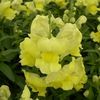
|
SnapdragonsBotanical Name: Antirrhinum majus
Available spring-summer-fall Cultivars 2022 [ More Info ]
|
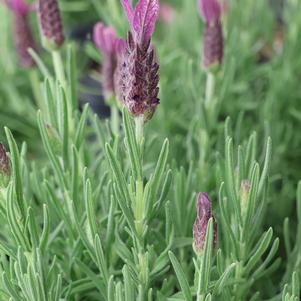
|
Spanish LavenderBotanical Name: Lavandula stoechas 'Primavera'
Spanish Lavender 'Primavera' is a popular lavender cultivar known for its vibrant and striking appearance. 'Primavera' is a compact plant that typically reaches a height of about 12 to 16 inches and forms a bushy, rounded shape. The foliage consists of narrow, grey-green leaves that provide an attractive backdrop for the showy flowers. One of the notable features of Lavandula stoechas 'Primavera' is its eye-catching flowers. The blooms are held on sturdy, upright stems above the foliage, creating an elegant display. The flowers are typically deep purple or violet in color, with bracts that resemble rabbit ears, giving it the common name of Spanish lavender or rabbit ear lavender. This compact size makes it suitable for various garden settings, including containers, borders, or rock gardens. The grey-green leaves provide an appealing contrast to the colorful flowers and contribute to the overall aesthetic appeal of the plant. [ More Info ]
|
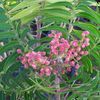
|
Sumac, FlameleafBotanical Name: Rhus copallina
A Texas native shrub that tries to be a small tree, however the stems are thin and droop easily with age. Naturally forms an irregular crown with crooked, spreading branches. Underground rhizomes, coupled with its ease of self-seeding, allow this Sumac to quickly create thickets and massings. The name “Winged Sumac” comes from the easily identifiable leaf stalk being winged between leaflets. The dark green foliage in the summer is complimented by the large tight terminal panicle of flowers, yellow-green in color. “Flame Leaf Sumac” comes from the outstanding red foliage in the fall, which is complimented by the multitude of red drupe berries following the blooms mid-summer. This sumac is very low maintenance, and highly drought tolerant; an ideal choice for harsh landscape environments that demand some type of vegetation. [ More Info ]
|

|
Super Chili PepperBotanical Name: Capsicum annumm
Super Chili pepper plant is a very productive semi-compact pepper plant with upward facing chili peppers with a surprising kick to them. Start out as green, turning orange to red. [ More Info ]
|
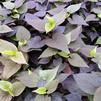
|
Sweet Potato, Black HeartBotanical Name: Ipomoea batatas
Medium-fast growing perennial vine with black heart-shaped leaves. Tolerates the Texas heat and full sun, but exhibits much richer color when grown in partial shade. Grows best in well-drained but moist soils either as a groundcover or cascading in hanging baskets. [ More Info ]
|
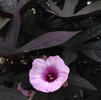
|
Sweet Potato, BlackieBotanical Name: Ipomoea batatas 'Blackie'
Medium-fast growing perennial vine with black heart-shaped leaves. Tolerates the Texas heat and full sun, but exhibits much richer color when grown in partial shade. Grows best in well-drained but moist soils either as a groundcover or cascading in hanging baskets. Small blooms are biolet to lavender in color. [ More Info ]
|
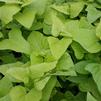
|
Sweet Potato, MargueriteBotanical Name: Ipomoea batatas 'Marguerite'
Medium-fast growing perennial vine with lime green heart-shaped leaves. Tolerates the Texas heat and full sun, but exhibits much richer color when grown in partial shade. Grows best in well-drained but moist soils either as a groundcover or cascading in hanging baskets. [ More Info ]
|
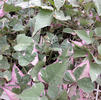
|
Sweet Potato, VariegatedBotanical Name: Ipomoea tricolor
Fast growing perennial vine with bright green heart-shaped leaves with tri-color variegated leaves. Trumpet shaped flowers can be up to five inches in diameter, opening in the morning and lasting only for one day. They are commonly grown as an annual vine, and can easily take over the area - a great choice for areas that can be unsightly year around but not easy to remove, such as fences, dead trees, or brush piles. [ More Info ]
|
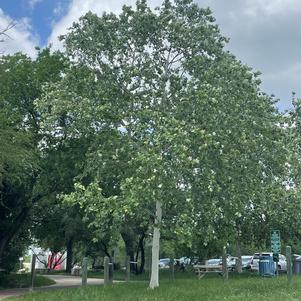
|
Sycamore, MexicanBotanical Name: Platanus occidentalis 'Mexicana'
The Mexican Sycamore was introduced to the Southern Texas landscapes in the past decade; its higher resistance to bacterial leaf scorch makes it a superior substitute to the American Sycamore. In addition, it prefers alkaline soils and is generally insect and disease free; very fast growing. The bark peels off in irregular patches as the tree grows, giving a handsome mottled look. The top of the large leaves are green, while undersides a silvery pubescent hue, growing up to eight inches across. They turn brown in the fall and if windy, blow effortlessly into your neighbor’s yard, saving you time and energy in raking them up. Mexican Sycamore is monoecious, meaning male and female flowers are separated but borne on the same tree, and pollinated by the wind. Pollinated female flowers will form a stiff ball, covered with densely compacted mesh of several hundred seeds, forming a ball measuring 1.5 inches in diameter. In the winter, the cohesion of the ball breaks down releasing the hundreds of seeds into the wind to be blown away – maybe to your neighbor’s yard yet again – the gift that keeps giving! [ More Info ]
|
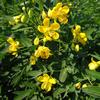
|
Texas SennaBotanical Name: Senna corymbosa
Senna is a native of Argentina, Brazil, and Uruguay that has naturalized itself very well to central & southern Texas. It was incorrectly named Cassia falcata, and outside of Texas known as Argentina Senna. Senna does best in full sun and in well-drained soil, tolerating the summer heat and drought conditions quite well. Racemes of golden-yellow flowers appear in the spring and continue till the fall, attracting bees and butterflies. May experience dieback in colder winters, however will return in spring giving up to five feet of growth for the season. [ More Info ]
|
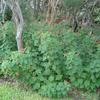
|
Turk's CapBotanical Name: Malvaviscus arboreus var. Drummondii
Shade tolerant perennial with an upright growth habit. Fushia-pink flowers appear summer to fall. Reaches four feet in height and two feet width.
[ More Info ]
|
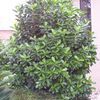
|
Viburnum, awabukiBotanical Name: Viburnum awabuki 'Chindo'
A native to South Korea, Awabuki is one of the fastest growing viburnums available. The leaves emerge light green, turning dark green and reaching up to eight inches long; they are very lustrous and have a leathery texture to them. It’s best to prune in late winter to promote even, uniform growth throughout the summer – it won’t hurt to prune the excessive growth midsummer to put another flush round of foliage before winter. Grows unchecked as a large shrub, but can easily be trimmed into a small, multi-branched tree with a natural round canopy. Fragrant white blooms appear in the late spring, leaving red berries soon after that turn black by the fall, attracting birds easily. As with all viburnums, it has some of the highest deer tolerance. Best grown in moist, fertile soils but can be forgiving of slightly less conditions. [ More Info ]
|
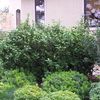
|
Viburnum, SuspensumBotanical Name: Viburnum suspensum
Native to Japan, the Sandankwa Viburnum is an excellent deer resistant shrub with an open spreading growth habit. Branches quickly grow out of the main shrub, but regular pruning will encourage a small, compact and full shape. Unpruned, it will grow ragged, reaching up to twelve feet tall and wide. The leaves start light green, but become dark green as they mature. They are oval-shaped with serrated edges, highly aromatic, and sometimes used in flower arrangements. Small tubular flowers are borne on the ends of new branches in the spring, and sporadically appear in the summer. They are white to pale pink, followed by small red berries in the fall that attract wildlife. Moist, well drained soils are highly recommended. [ More Info ]
|
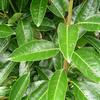
|
Viburnum, SweetBotanical Name: Viburnum odoratissimum
The Sweet Viburnum is an excellent large shrub or small tree native to Asia that has established itself in the Texan landscape. It is fast growing and relatively pest and disease free, and as a viburnum it’s as deer resistant as any plant can hope for. The smooth, leathery leaves can grow up to six inches long; they are dull green on one side and bright green on the other. In full sun, it creates a thick and lush shrub that is ideal for privacy screens or sound breaks along fence lines. In the shade it will not grow as robust, but slight pruning will encourage thicker growth. With only minimum pruning of lower branches, it easily forms into a small tree with a natural multi-trunked canopy. In the spring, tiny white flowers nearly cover the entire plant and are very fragrant, contributing to its name. Red drupe berries follow, turning black in the fall, attracting birds easily. [ More Info ]
|
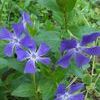
|
Vinca MajorBotanical Name: Vinca major
Evergreen vine that spreads up to five feet in width, and grows slightly over 12 inches in height. Light blue flowers appear on new growth throughout the spring and summer.
[ More Info ]
|

|
Vinca PeriwinkleBotanical Name: Catharanthus roseus
2024 [ More Info ]
|
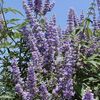
|
Vitex, Chaste TreeBotanical Name: Vitex agnus-castus
Vitex, also known as Chaste Tree, is a small deciduous ornamental tree that grows fairly fast and is tolerant of adverse environments such as heat, drought, high winds, and poor soil types. Although native to Europe and Asia, it has become naturalized in the southern states and used extensively. [ More Info ]
|
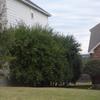
|
XylosmaBotanical Name: Xylosma congestum
Native to China, the Xylosma is an ideal selection for privacy screens, windbreaks, or foundation plantings as it grows wider than it gets tall. Commonly grown as a shrub, it can be pruned into a tree form. New foliage starts out red to bronze, then turns glossy green while on long, graceful arching stems. Xylosma isn’t susceptible to many plant diseases or pest. Inconspicuous yellow-green blooms appear in the early fall, but are followed by small black fruits that compliment the foliage well. Although evergreen, the Xylosma can drop leaves if exposed to freezing temperatures. [ More Info ]
|
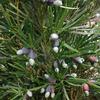
|
Yew, JapaneseBotanical Name: Podocarpus macrophyllus
Slow growing evergreen shrub native to Japan and southern China that has adapted well to the southern landscape. Naturally forms a conical to dome shape, and is commonly pruned into uniformed shapes for hedges, topiaries, or screens. The foliage is dark green and needlelike, whorled around the stems. Male plants have catkins that produce pollen. The females produce blue-green berries attached to attractive, yet mildly toxic, droop fruits that can be red, yellow, and dark purple. The Japanese Yew tolerates poor soil conditions as long as good drainage is provided. Japanese Yew grows well in the shade and sun, and can fit a variety of landscape needs when pruned into any form. [ More Info ]
|

|
Yucca, Adam's Needle Leaf (Variegated)Botanical Name: Yucca filamentosa 'Variegata'
[ More Info ]
|
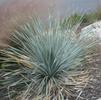
|
Yucca, Blue SotolBotanical Name: Dasylirion wheeleri
Inappropriately named, the Blue Sotol Yucca is a member of the Lily Family. Despite this, it is a tough and durable Texas native that makes a fine addition in any Texas landscape. Blue Sotol forms a rosette of blue-green leaves that are only up to three feet long, but are lined with a multitude of very sharp spines; be sure to plant away from any walking paths. Extravagant flower stalks can reach up to fifteen feet in height, then the flower spike reaches an additional three feet. Numerous small white flowers appear on the flower spike starting in mid-summer and persist into the fall, easily attracting butterflies. The Blue Sotol Yucca is dioecious, meaning the flowers are either male or female on the single plant.
[ More Info ]
|
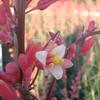
|
Yucca, RedBotanical Name: Hesperaloe parviflora
A Texas native succulent plant that is an ideal choice for hot and dry areas. The leaves grow up to four feet long, rolled up halfway and have curly threads along the margins. It will form clumps over time, reaching an average width of five feet. Flower stalks first appear in the spring and through the summer bearing many coral-pink flowers that attract butterflies and hummingbirds. Red Yucca is tolerant of many adverse soil conditions and blooms best in full sun. It also tolerates salty environments. [ More Info ]
|
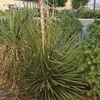
|
Yucca, SotolBotanical Name: Dasylirion texanum
Inappropriately named, the Sotol Yucca is a member of the Lily Family. Despite this, it is a tough and durable Texas native that makes a fine addition in any Texas landscape. Sotol forms a rosette of leaves that are only up to three feet long, but are lined with a multitude of very sharp spines; be sure to plant away from any walking paths. Extravagant flower stalks can reach up to fifteen feet in height, then the flower spike reaches an additional three feet. Numerous small greenish-white flowers appear on the flower spike starting in mid-summer and persist into the fall, easily attracting butterflies. The Sotol Yucca is dioecious, meaning the flowers are either male or female on the single plant.
[ More Info ]
|
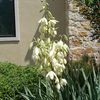
|
Yucca, WeepingBotanical Name: Yucca recurvifolia
A naturalized Texas shrub with excellent tolerance to hot and dry climates. The blueish-green flat leaves have a sharp tip, and grow up to three feet in length, bending downward over time. Weeping Yucca begins as a uniform rosette shrub, growing upward on a single trunk reaching heights of five to six feet before falling over its own weight. New trunks will sprout where the main trunk makes contact with the ground, making it a multi-trunk shrub. The flower stalk can grow up to five feet above the foliage, displaying a large cluster of white to pale yellow bell-shaped flowers in the early spring that last into the summer. [ More Info ]
|
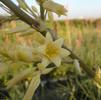
|
Yucca, Yellow BloomingBotanical Name: Hesperaloe parviflora
A Texas native succulent plant that is an ideal choice for hot and dry areas. The leaves grow up to four feet long, rolled up halfway and have curly threads along the margins. It will form clumps over time, reaching an average width of five feet. Just like the regular Red Yucca, the flower stalks first appear in the spring and through the summer bearing many yellow flowers that attract butterflies and hummingbirds. This yellow blooming Yucca is tolerant of many adverse soil conditions and blooms best in full sun. It also tolerates salty environments. [ More Info ]
|
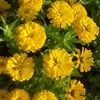
|
ZinniaBotanical Name: Zinnia elegans
Mortellaro's Nursery stocks only dwarf cultivars of Zinnia elegans. This attractive annual has an upright bushy growth habit, with solitary daisy like flowers in a variety of colors. Zinnias are best planted in well drained soil in full sun, and watered infrequently as they are susceptible to leaf spot and mildew. The best way to inhibit powdery mildew is plant them in an open space with plenty of air circulation. They are an ideal Texas summer annual as it enjoys the hot summers up till the first fall frost. [ More Info ]
|
